Spain and the EASA Licence
Living in a mirror world
Living in a mirror world
Local Axarquia LEAX 29 Sep 20
Ann has rented an apartment near Fuengirola for a year and we happen to be staying an hour away, East of Malaga. As she is there for so long she is investigating the possibility of doing some flying in the warm sun of Southern Spain and following a lot of delays and lack of communication the Real Aeroclub de Malaga have decided to let her, and myself, fly with them, if we can pass the checkout...
Axarquia Airport is worth exploring as it is one of the few GA destinations on the South coast of Spain (the other being Jerez, but that's a way away from Malaga): the Spanish are, on the whole too poor for GA and the land is rugged around here. Malaga "Costa del Sol" airport does not have aircraft to rent (and looks stupidly expensive to land at: one of the "Mandatory Handling" brigade, basically) and there isn't anything else close.
It is a small, dusty, hard to find but surprisingly well-equipped airport. The main runway is 959m long but R12 has a hugely displaced threshold, only allowing a usable 630m. There are vines off the end of the runway to the North West but not that close, and a hill making a low approach to the non-displaced section of the runway close to the ground, a bit like Shoreham, but it all seems a bit pointless.
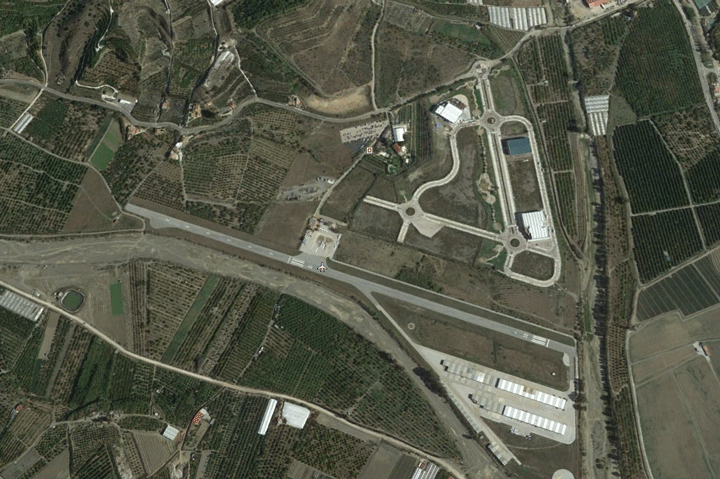
Staggeringly, as they train airline pilots there on Diamond DA40s and the place was crawling with swarthy looking young Spaniards in full instructor gear, jerseys and all (phew: too hot for that...), the standard circuit calls are made (against all ICAO regulations), in Spanish!
My Spanish is almost non-existent so we have made up a quick Spanish circuit call cheat sheet the night before.
But from what we both heard, they make completely non-standard, chatty, indecipherably-Spanish calls that don't even include "a favor del viento" (downwind), "arriba" (overhead) or "atterizaje" (landing").
God knows how anyone non-Spanish is expected to use the place.
We have an ulterior motive here: at some point a trip down from the UK by Whisky Lima would be quite a nice long-distance cross-country and if we are familiar with the destination it will help... As we can't travel long-haul at present due to the Coronavirus this might make an interesting distraction.
Oliver, our check out instructor, introduces me to the Piper Warrior 161 which feels very familiar. Minimal pre-flight checks, he just wants 3 circuits, so we start up and taxy out. He does the radio (with a hand mic and no heaphones!) which seems unnecessarily primitive, and I reckon this would be the main stumbling block. They want everyone to join overhead and do circuits to the SW, which is fine but if you join from the lake-to-the-North reporting point you're going to tie yourself in knots trying to do an Overhead Join - probably best to just join crosswind having done the descent to the North East (the Dead Side).
[Early-2025 note: Oliver died doing aerobatics. At least he died doing what he enjoyed]
Backtrack R12, quick power checks and we're off with 1 stage of flaps, rotate at 65 then push for 75, climb to 1000ft for Downwind, no wobbly prop so it's just the bloody fuel pump to remember then BUMPFTCH (but no visible moisture so he reckons no need for Carb Heat. Hum: maybe) and round for the approach.
It's a bit bumpy coming down, we'll mind the hill, mind the displaced threshold and find I'm fighting the aircraft a bit. The vines make for plenty of sink then suddenly you're over the hot displaced threshold and ballooning. Make a bit of a hash of the first one but the second one is better and by the third one he announces "Perfecto!" and we taxy in.
Is that it? Blimey: quickest checkout I've ever had.
Local Alcocer de la Planes Nov 22
Two house moves, the sale of my C182 share and a relocation to Spain took up the whole of Autumn 2022 but now it's 2023 so I can think again about what I am going to fly and where.
Today we are going to fly a Tecnam P92 2 seater microlite around the Marina Alta area of Eastern Spain. My new friend Simon has kindly agreed to take me up for a look around and some idea of how Spanish GA works. I've flown a P92 before so this should be fun.
Arriving at the Alcocer de Planes strip in the surprisingly cold depths of a Spanish valley 1,000ft above sea level in November the contrast with the uber-efficient Oxford hangar set up could not be greater. This is a mud strip with some tin hangars and two Tecnams. These count as ULMs or microlites and you can fly them with a Spanish microlite licence. I am told by Sante the instructor and examiner that I do not need a Spanish medical or indeed an exam to fly these, just a few hours of difference training and a checkout. Wow....
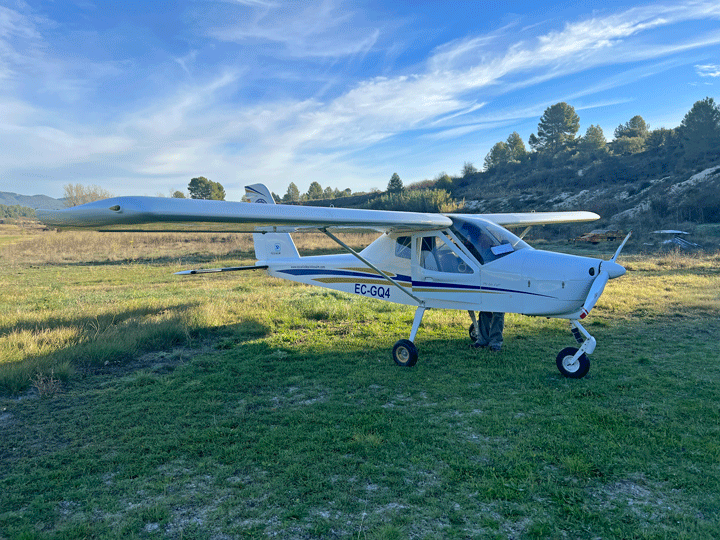
|

|
|---|---|

|
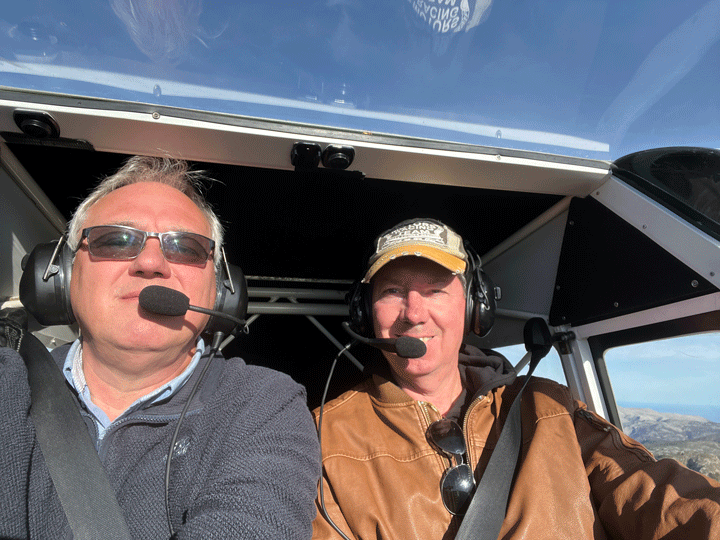
|
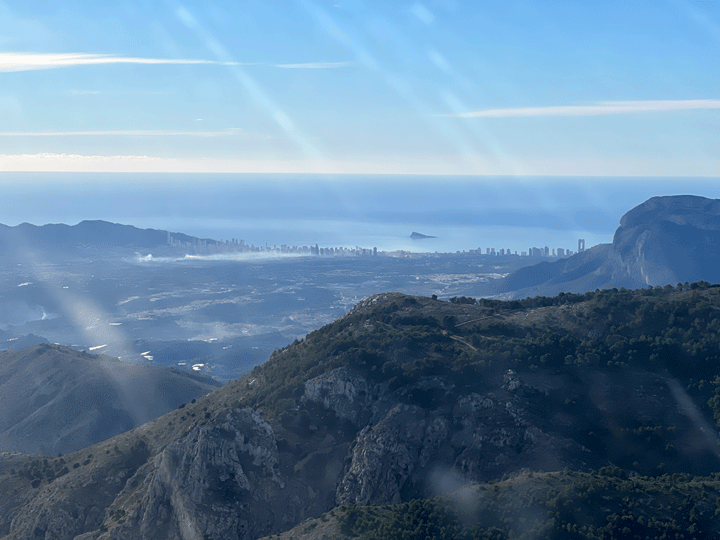
|

|
We squeeze ourselves in to the tiny cockpit: head in first, then bum, then legs. It's basic but it seems everything is there including GPS and some hybrid analogue / digital instruments. I worry about the lack of an AH but this is meant to be a VFR-only machine.... After an extended period of warm up (it's cold this morning) we taxy to the run up (no power checks, no SPLAT check, no take off clearance?) and roll.
I have to say I expect the Rotax to struggle with both Simon (no lightweight) and myself (again, no lightweight) but at 40Kts it simply flies itself off after an impressive 250m or so and we establish a 500ft/min rate of climb. It's actually not that noisy (although ANR headsets help, I suppose) and not draughty at all.
After a bit of sight-seeing (and the mountains and coastal plains are pretty cool, but then that was why we moved here) I get a go. Electric trim, electric flaps, transmit is on the top of the stick and it flies happily hands off. Rudder is very effective and in fact in cruise you can tool it around just using the rudder... nice.
Steep turns aside (and we don't try these as I really don't want to overstress the airframe) it is very responsive without being ludicrously twitchy - the Agusta A109 I flew last summer was much twitchier. You do need power to keep the nose up in turns, it doesn't have the C182's truck-like ability to soldier on through any manoeuvre without power changes, but there doesn't seem any great absence of power here.
We fly over our new house (and amazingly Nessa doesn't see us) then back up over the hills. It's very smooth in the winter but more thermally in the summer apparently. As this part of Spain gets 300 days of sunshine a year I'd be amazed if there are very many totally IFR days, so the need for an IR(R) is probably less.... I'll be spending some time in the UK as well, hopefully out of Compton Abbas (when it's dry enough to operate), it will be interesting to experience the contrast.
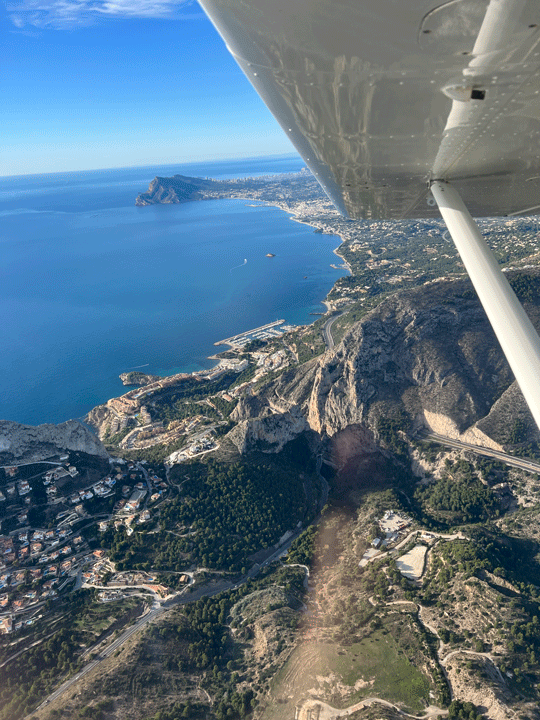
|

|
|---|---|
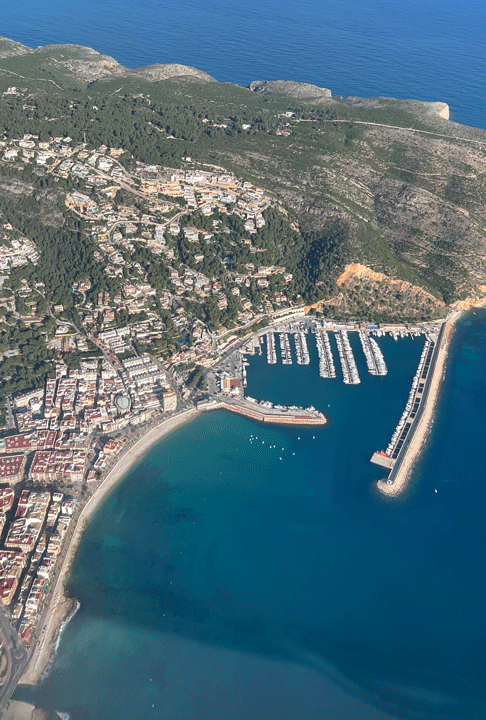
|
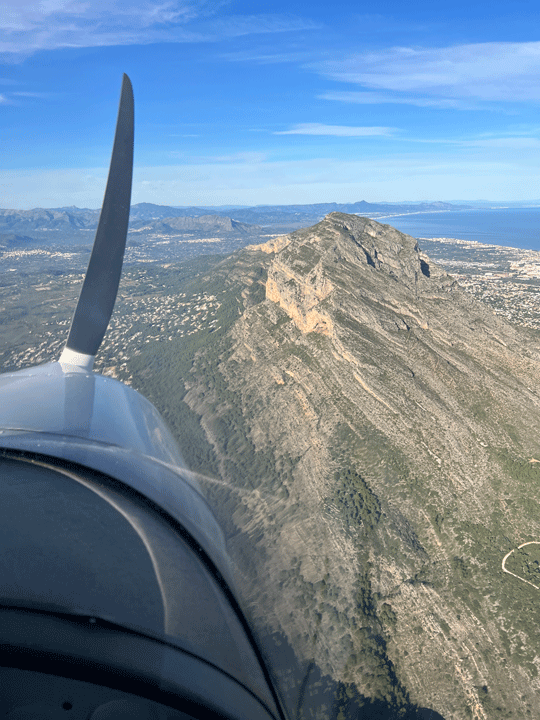
|

|

|
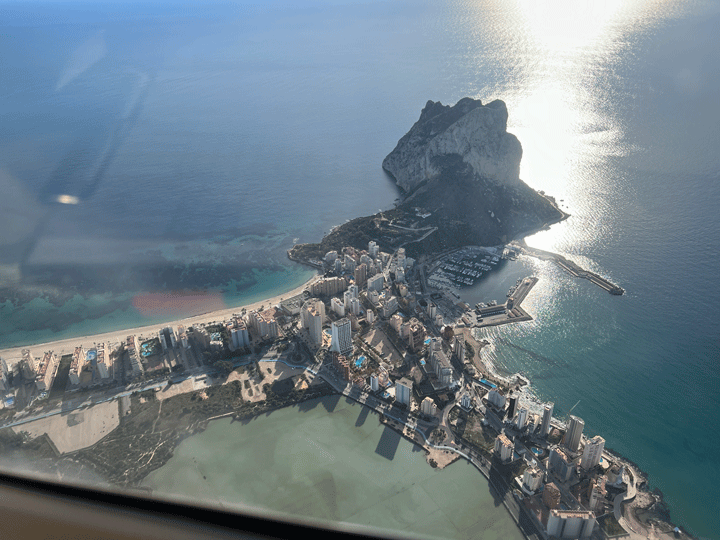 We return to the airfield after an hour, surprisingly warm and here is where a microlite is different: he performs what feels like a very steep glide approach in to the muddy strip that calls itself a runway.
We return to the airfield after an hour, surprisingly warm and here is where a microlite is different: he performs what feels like a very steep glide approach in to the muddy strip that calls itself a runway.
There is much less momentum in the aircraft and if you lose power or get low on the approach it can all go pear-shaped very quickly so they fly steeper approaches than I am used to: no "3° approach and needles crossed at 4 miles" here.
He pops the aircraft neatly on and it stops in no time at all, but that would need a bit of getting used to.
A rather nice piece of "fly the wing" confirmation - you're on Final with a crosswind and you don't want to land the aircraft sideways, which will stress the undercarriage and your passengers. So you switch to "wing down". Pointing a wing at the ground seems counter-intuitive until you try going out in a strong wind wearing a peaked cap. You need to keep the peak of the cap pointed towards the ground into wind otherwise the wind gets under the cap and flips it off your head. To really appreciate the effect turn the cap 90deg sideways and turn so the wind is heading for the peak. That's a cap down / wing down scenario.
Local Muchamiel 1 Feb 23
This is all very different: I haven't flown since August last year and now it's February. I'm in a different country flying a different aircraft under different Airspace rules. And as the UK has left EASA (what did they think they were doing?), a different licence.
Muchamiel is a mixed use airfield with a decent 1000m bit of tarmac but SkyDemon warns me the approach to R12 is steep and the runway slopes down. The apron is full of rescue and firefighting helicopters and a small contingent of Diamonds being used to train airline pilots.
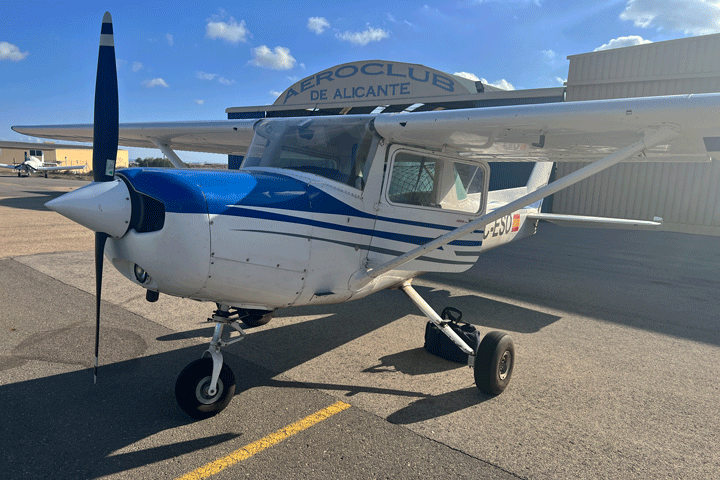 My instructor asks how many hours I have: he gets a few mad Englishmen here but I don't think he's had one with nearly 600 hours before. This should be fun.
My instructor asks how many hours I have: he gets a few mad Englishmen here but I don't think he's had one with nearly 600 hours before. This should be fun.
In Spain any flight transiting Controlled Airspace requires a VFR flight plan, which actually makes some sense, I suppose.
It seems a bit overkill but definitely the legacy of Franco, who loved to control everything and everyone.
These guys certainly love their bureaucracy.
The flight plan of course has to be filled out in Spanish on the worlds slowest PC, but actually enaire.es is reasonably straightforward and doesn't time out when you stop for a quick Google Translate or a chat (unlike some other systems I could mention).
It's less clunky than the UK system but doesn't seem to offer the ability to load a boilerplate FPL and modify only todays bits (or at least not that I can find). Fortunately Chrome's auto-fill comes to the rescue here, and going forwards SkyDemon FPL's are much easier to use.
The website also gives you weather, NOTAMs and spot winds for your chosen route so there is some value there over and above a quickie FPL with SkyDemon from your phone in the cafe next door.
 The Cessna 152 feels tiny after the Gentleman's Club C182, and despite my instructors protestations to the contrary, with full tanks we are well over MAUW.
The Cessna 152 feels tiny after the Gentleman's Club C182, and despite my instructors protestations to the contrary, with full tanks we are well over MAUW.
We have a long runway, it's cool and we are virtually at sea level. But neither of us are lightweights. We won't expect too much in climb performance.
Apart from no strobes, the aircraft is as normal but their checklist does not include checking the function of the lights, and there is no stall Warner I can see. Hmmmm….
There is a certain amount of confusion in taxying as absolutely nothing is marked so where the holds are is anyone's guess. OI do eventually get a map but it's not available publicly anywhere.
It's all a bit made up, and not exactly CAP413. We hold short at N2 and enquire if anyone us on base or final before entering and backtracking R12.
There is a tower and there are people up there but enquiries as to the QNH or runway in use elicit no response. Fortunately I checked the QNH in the office before we left and the PA-31 that's just taken off has used R12. So we will as well.
So, to the take off. Amazingly, the poor little thing does fly off when we rotate at 60Kts with 10deg flap and it does climb, so that W&B can go hang itself. It will be a different matter in the summer.
Circuit height is 1200ft QNH and the airfield is at 475ft AMSL so actual circuit height is 725ft AGL which is really low. And they fly tiny little circuits so you're not at 1200ft until well in to downwind so by the time you've called downwind and BUMFTTCH'd it's time to whack the flaps out, roll the throttle back and descend…. It's all a bit rushed.
We depart North via a VRP which is a big motorway roundabout and switch to Valencia approach. We are within sight of Alicante International Airport, arguably a larger and more important airport than Valencia, but Valencia's airspace reaches right down to well beyond Alicante, down past Murcia, another big airport. Pretty weird. We just state our call sign, don't even ask for anything and they acknowledge our presence and give us a squawk (which we then forget to release later). The worlds oldest transponder (I had to wind it up manually) gets laboriously programmed and off we go.
Not bad, this little C152. You can spin them though this one is clearly placarded NO INTENTIONAL AEROBATICS OR SPINNING. Well, certainly not above MAUW.
We fly up the coast to Benidorm. A low level run over the beaches can wait, for today we'll turn inland, climb over the mountains until we reach the col right above our house, cross the ridge at 45deg so if we hit a down draft we don't like we can turn back, but there's nothing today and we chop the throttle and descend in to our valley, a quick couple of passes and we climb up for the col once more. No, we won't make that, the poor little aircraft's climb performance is inadequate to make it so we settle for a lower col and with all the suck from the trees we are barely climbing. Not until we eventually breast the ridge and head down do I realise we had both failed to spot me leaving the carb heat on. Idiot!
So back for some circuits and this is where I feel all fingers and thumbs. It's a tricky little approach this one. Allied to the minuscule circuits are some fairly decent power lines and a housing estate then a road and a line of trees. The road is higher than the runway so you have to leave clearance over the trees then chop the power to descend. My poor instructor doesn't trust me enough yet to allow an offset approach over the lower ground or a closer approach to the trees so we are consistently high over the numbers. I can land it OK with varying degrees of flap (amazingly the wheels-touch height feels higher than a C182) but we're a long way down the runway each time and I'm getting frustrated so on about the 4th approach I pass the trees and just slip it. That wakes him up because at last the approach picture looks more sensible but he doesn't yet trust me enough to keep the nose down whilst slipping. Poor guy, I didn't warn him. We'll do more.
After 7 approaches we're both hot and sweaty, so we call it a day and taxy in.
Some of my flying was good, some was crap but it was all safe and we enjoyed it. The procedures are a bit different but an aircraft is an aircraft and I'm looking forward to more in a few weeks.
Local Muchamiel 7 Mar 23
Since Britain has opted out of EASA you need to have an EASA PPL to fly an EC-registered aircraft, and this will require:
- 5 hours with an Intsructor
- Two exams: Air Law and Human Performance
- An EASA Class 2 Medical
- A Skills Test
- Proof that you have as many hours as you say you have
So this will be an interesting experience. I don't actually mind the time with the instructor as it is very useful to be able to learn local procedures and anyway who doesn't need a bit of brushing up?
Today we fly the C172, the most manufactured aircraft by numbers ever and from what I remember from flying G-CBFO a number of years ago the secret is not to be too fast on the approach or you will simply float all the way down the runway. I would hope I've learned a bit about speed control since then.
This is a relatively new, fuel injected model and has clearly been flown in pretty much stock from the US as the altimeter subscale is in inches of Mercury, not Hectopascals. There is a conversion table next to it. Not sure that would pass CAA regs.
The checklist inside is in Spanish, so we opt to use mine, which is of course for a different aircraft. I'm not precious enough about this chcecklist not to write in it, so we modify it to suit as we go along.
Being fuel-injected, there is no carb heat and the fuel pump is only used for pre-start prime, then it's mixture lean, crack the throttle and push the mixture in when it catches.
Strangely, this aircraft has no starter warning light. I try very hard to explain what a starter warning light is to my instructor but his English isn't good enough and my Spanish certainly isn't. One for later.
It also has 2 Garmin G5s, this will be fun. It's what we were going to fit to the C182 anyway.
My instructor announces it's going to be a "hot" day today and asks what we should be expecting? The obvious answer is reduced performance from the engine and the wing, especially combined with any height (495ft here won't make much difference, but somewhere like Teruel will) resulting in longer runway roll and reduced climb performance. Trotting out my Jersey overload story, he gets that I know what the issues are.
I now have an airfield map and we can write on it the unmarked and undocumented Hold points. Local knowledge is everything.
We request a radio check and airfield info from the tower and they do this time actually answer in English, to give us the QNH and to confirm our radio is working, but no indication of which runway it might be best to use. Huh?
The windsock is favouring runway 30 so we'll declare that is what we're going to use, ask if anyone is on Base or Final, look both ways, SPLAT and taxy out. If we see anyone landing they will either go round or as a last resort we can just exit on to the grass.
Turn at the end and roll. Rotate at 55Kts with 10deg flap and this feels much more stable and powerful, the poor old C152 was at the limits of its performance with a couple of fat blokes on board.
I know now where to point the aircraft for the crosswind and downwind legs (big rock, and big tower blocks on the seafront), so do a creditable circuit and turn Final. Apart from the motorway and some power lines, this looks relatively easy although some greenery near the motorway gives us a bit of suck and a sharp intake of breath from our instructor. We're fine, but I overcompensate and arrive at the threshold high, and fast. We'll just land further down the runway, thinks I.
No, the large helicopter (a Huey, I think) Holding at N1 has other ideas. He clearly has some lift on because as we float past him low and slow, we're blasted sideways and upwards, I can hear the pre-stall airframe whistle I know so well. My instincts tell me to PUSH and POWER, which is of course just the right thing to do. Pushing lowers the AofA and power stabilises the whole thing. If I was on my own I'd probably then pull the power off, regain the centre of the runway and land further down but with an Instructor on board I think we'll just go round. "Right decision" he says.
This time, half way down the downwind leg the helicopter is now occupying where I want to be for the approach and chatting volubly in Spanish. My instructor chats away to him for quite some time and I think we'll just extend downwind until he's worked out what he wants to do. I still don't know what he is doing but he is slowly moving away so as we near the tower blocks on the seafront we'll roll base, start the descent and with a longer approach and a heavier aircraft it all feels so much more in control.
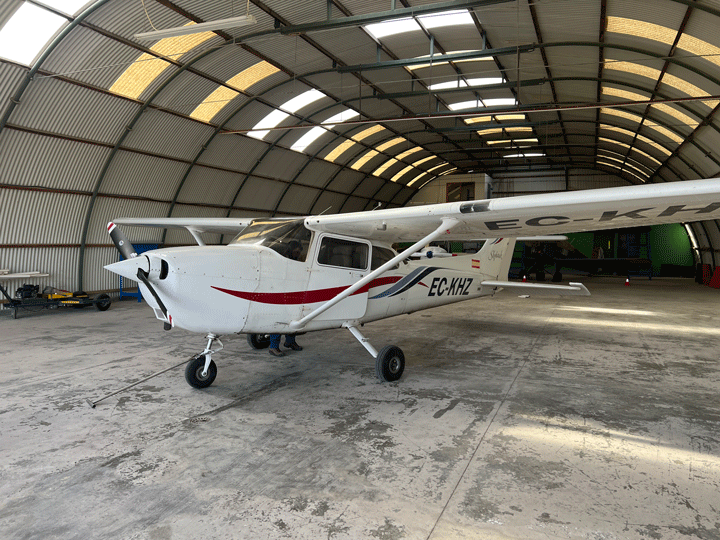
|
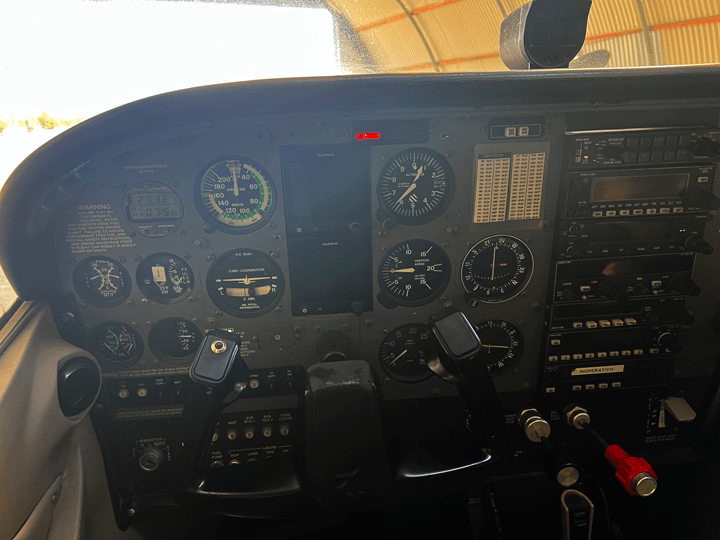
|
|---|---|
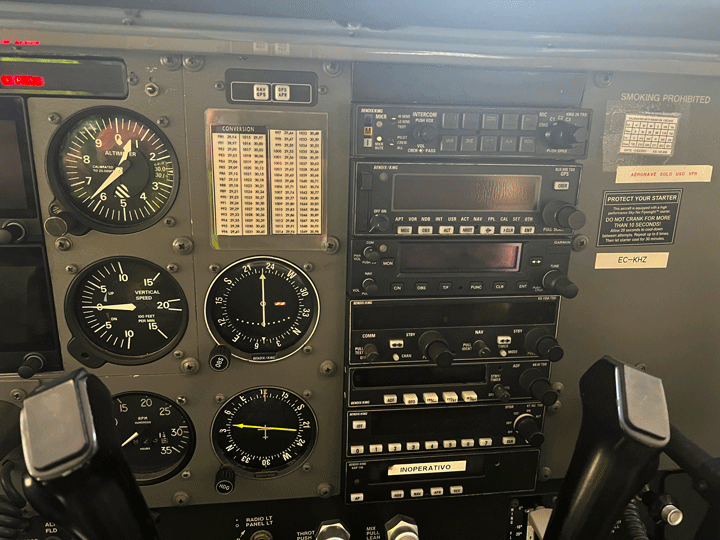
|
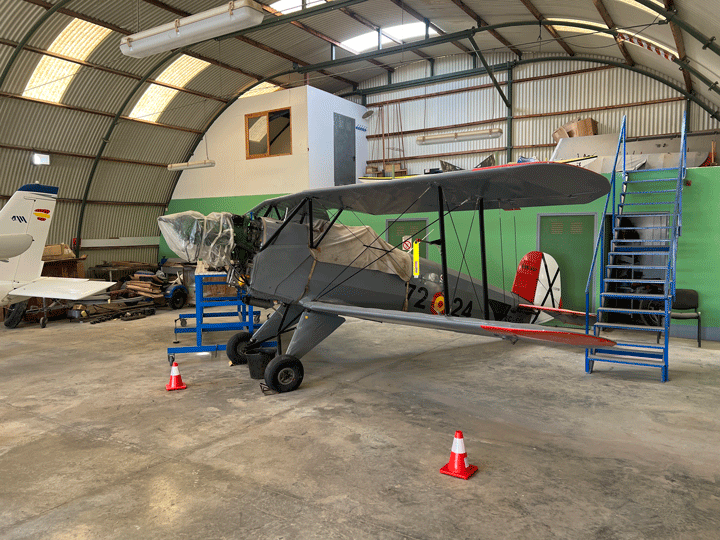
|
The old saying "good approach, good landing" does work and we plop it on with a bit of a squeak and way off the centreline, but it's getting there, so open up and climb out.
"Nice landing" he says.
"No, it was rubbish"
The wind is increasing and forecast to be gusting to 25Kts but it's almost straight down the runway so I'm not too bothered, but as we do the approach the third time it's a lot rougher. Ha, I can do this, I've done Dinard in 44Kts. Lots of control corrections, fight it all the way down and this time we pull a greaser out of the random box of landings.
My instructor says he can see the rust coming off now. He's right. He's also relaxing and beginning to realise I know what I'm doing.
We'll stay down as he has another lesson, exit and call vacated, park the aircraft and push it back in to the hangar.
Meanwhile, he tells me about landing back at Muchamiel virtually at night (they've no instrument apoproaches and no lights). I need to ask him what his alternate plan was had he been a few minutes later?
He says he loves my super clear radio chat, but he doesn't know the reason: training at Oxford you bloody well learn to do the radio properly because they're training airline pilots there and so all the students are right up there and spot on, you don't want to sound like a pillock, and you only get Transits through Solent if you sound like you know what you're doing! Of course flying with an ex-BA B757 Captain has also helped.
That's 2hrs out of my 5hrs with an Instructor required, and I have an AME lined up for the Medical. EasyEASA.com will hep me with the exam prep, now I just need to sort out getting my logbook verified.
Flying the C172 is easier and more spouse-friendly than the C152, and I suspect the aircraft is underused for training as it's more expensive than the C152.
The CASA Jungmann trainer looks interesting, though.
Local Muchamiel 15 Mar 23
 Flying in Spain does not require an IR. On the vanishingly few IMC days you just don't go flying. I only need my IR(R) for the UK where the weather is just shite a lot of the time. An EASA IR is a lot of work both to achieve and to maintain. However an EASA enroute IR might just be the ticket, we'll see.
Flying in Spain does not require an IR. On the vanishingly few IMC days you just don't go flying. I only need my IR(R) for the UK where the weather is just shite a lot of the time. An EASA IR is a lot of work both to achieve and to maintain. However an EASA enroute IR might just be the ticket, we'll see.
Today is that Mythical Perfect Flying Day: sunny, warm, but not too hot and no gusty winds.
We discuss engine out scenarios and my instructor agrees that Spain is a rugged country, that maybe a motorway is a sensible solution, and also suggests the mud strip at Alcaceres de Planes. Having flown out of this I express doubt at putting a C172 in there but he says he has done this. I can sense a demonstration coming on when he suggests our next trip be up in to the mountains.
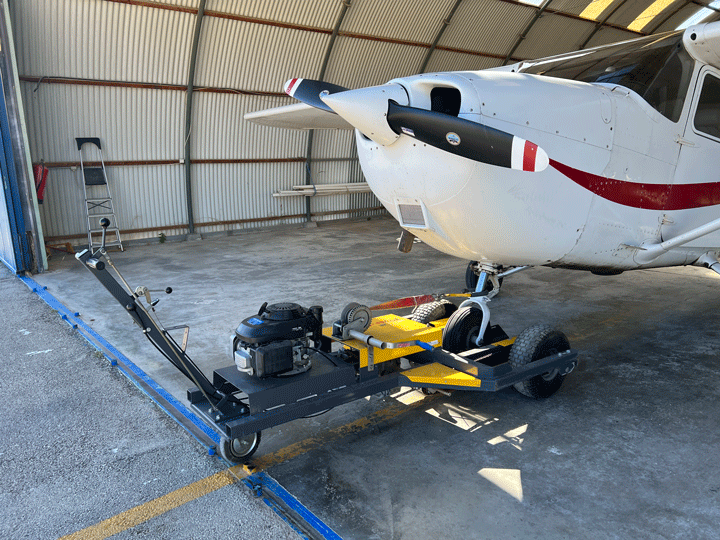 More of my mandatory 5 hours EASA training today: we've bashed the circuit enough to show my instructor I can land it now. We'll go off for some general handling, and the place we choose is 4000ft over Benidorm harbour.
More of my mandatory 5 hours EASA training today: we've bashed the circuit enough to show my instructor I can land it now. We'll go off for some general handling, and the place we choose is 4000ft over Benidorm harbour.
Some interesting proecures here..... for example, the fuel we siphon out of the 13 (yes, 13!) C172 drain points goes in to the aircraft tug tank. This might be the most powerful aircraft tug in existence: running a conventional 4-stroke petrol engine on LL100 means it really goes well. And we'll use it today to pull the aircraft out. Parking brake on, push the tug forward so the nose wheel goes up on the little ramp, attach the strop (always work from the non-exhaust side of the aircraft to avoid getting burnt!), wind up the strop on the ratchet then start the engine and gently ease the aircraft out and round. Reverse the ratchet, loosen the nose wheel and back the tug off, set the parking brake and put the tug away. All very easy.
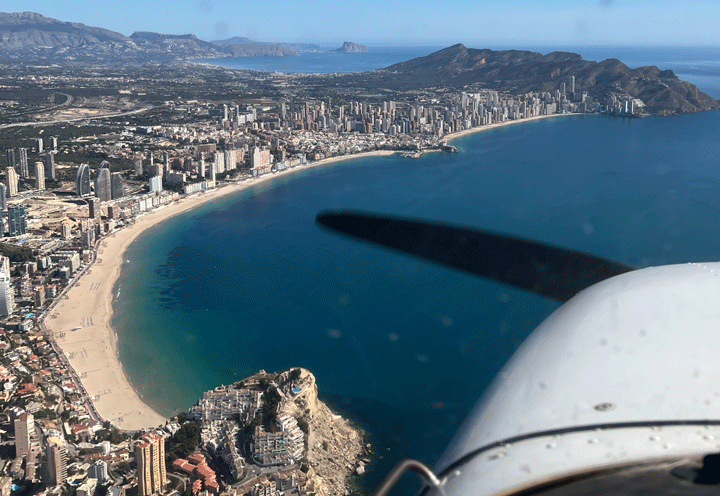 Starting this injected C172 is fun: you have to put mixture and throttle all the way in, then run the fuel pump, otherwise you get no fuel on the fuel flow gauge and the engine won't start. Another lesson learned. With just 2 of us this C172 has good performance.
Starting this injected C172 is fun: you have to put mixture and throttle all the way in, then run the fuel pump, otherwise you get no fuel on the fuel flow gauge and the engine won't start. Another lesson learned. With just 2 of us this C172 has good performance.
My instructor comes up with an interesting little moniker to add to my pre-runway SPLAT check: "look left, look right, taxy light", although it does rather imply that you leave the taxy light on for the duration of the flight...
Procedures... I am getting confused between reporting points relevant to the airfield and reporting points relevant to Alicante approach. A litle homework is needed and I need to carry an abbreviated version of the airfield environs map.
We leave the airfield frequency and swap to what looks like Valencia as we did before but my instructor now refers to as "Alicante". Huh? We seem not to ask them for a Traffic or Basic Service, we just announce our existence and state maintaining 1500ft, they give us a squawk and we tell them we're off to Benidorm and some Spanish name I can't pronounce or find on the map (which turns out to be the Penyal d'Ifach - I can't even pronounce it, let alone find it...), they then give us a Traffic Service, which is handy.
Once clear of Valencia's Control Zone (and yes, it is Valencia's, not Alicante's) we can select 75Kts for Best rate of climb to 4000ft, level out, get it set up for cruise then HASELL check, clearing turns left and right (and we're on effectively a Traffic service from Valencia/Alicante) and slow it with full flap and trundle along at 55Kts for a bit.
No flap stall is easy, full flap stall requires an awful lot of pulling before it eventually nods its head. Big push to regain the AofA, power (we can slam it, it's an injected engine) and we lose...er, 75ft.
Steep turns: he'd like me to do a 45deg bank and not lose any height. So I can turn it in, stick a point on the nose in the horizon and keep it there as we go round. Actually, I'm more used to doing this IMC. He's determined to get me to lose height and only after about 6 rotations still within 20ft of our starting altitude does he give up and accept I just *may* have done this before (once or twice)….. so we try it the other way, I love doing this stuff.....
Thermals have now begun to appear and it's getting bumpy, I know this will get worse as the summer progresses.
We return to Muchamiel to tackle the tricky R12 approach. This time I extend downwind beyond the power lines, take a little more time getting on to Final and finesse the approach, not aiming to land it on the numbers, he suggests being over the threshold at 60Kts…..and we pass the threshold at exactly 60Kts. Nice, gentle approach, flare, gentle touch and roll out, backtrack to S3 and vacate. In a bigger aircraft with a longer Final and using more of the runway this is a non-event.
More Procedures: I wasn't aware that we need to close our VFR flight plan by phone after landing, like in France, so we do this and I store the number as a contact in my phone.
I have to prove I've flown more than 100hrs via a Spanish "Legal stamp" or "Apostille" of my logbook including the carried forward hours from my old logbook. Fortunately I know how to do this as various documents needed this when buying our house In Spain. The Aero Club don't have a clue what the process is or where I can get it done but there is a really good company in Coventry that does it very efficiently. However, they need a Solicitor's stamp of authenticity.
Bloody Hell, the bureaucracy in Spain.....
Local Muchamiel 5 Apr 23
More shenanigans with my Spanish instructor today: he wants to do emergencies so we will stay in the circuit. The C172 is predictable and we even manage to start it first time, so we'll start with a normal circuit. We discuss, but do not do, an engine failure after take off. Your only option here is the motorway, it must be said, there are few benign fields.
We're on runway 12 with the power lines and the dodgy threshold I just can't seem to land anywhere near: the ground is too high and the obstacles too tall on the approach for me to fly the approach low enough to get the wheels on until at least a third of the way down the runway.
A glide approach from the downwind leg works perfectly, but I'm too high even with flaps - we'd have been OK but the traditional mid-approach engine warming has me too far along the runway. We'd have survived it but we'd have been in the weeds at the end of the runway.
I would have tried a bit of slipping but it's not sufficiently automatic an instinct for an engine out scenario, so on the next circuit we deliberately try an approach with slipping which helps, but then he takes it to do some wild S turns I consider dangerously close to the scenery one side of the runway and that doesn't really help. This is starting to turn in to a "can we land it on the threshold?" mission.
We then try full flap and 50Kts on short final which seems ridiculous, the stall Warner chirping intermittently and still, when we flare over the last bits of scrubby land sloping down to the threshold, we pick up just enough ground effect to waft us across the markings for a neat arrival. We try several of these but even on the seventh and final attempt where it feels like I'm going to land on the scrub we just miss putting the wheels on the markings again.
EASA exams Mar 23
I found the Ground School exams hard the first time round, 15 years ago. It wasn't that the subjects were particularly difficult but the exam questions were multiple choice, designed to catch you out, there was often one question where the "correct" answer wasn't the correct answer and the pass mark was very high. It was very easy to fail.
I have to re-do Air Law and Human Performance and whilst a lot of the stuff I should know by now, I have forgotten a lot because basically I haven't ever need to actually know it, just where to fnd it. Now I need to know it, and the emphasis here is on weird stuff like the number of the ICAO Article relating to the transport of Dangerous Goods (18) or the registration markings on the aircraft (20). And also questions about joining Airways, which you'll never do VFR anyway so should be relegated to the IR syllabus.
I am pointed at the marvellous web site EasyEASA, which is a good way of getting you through the turgid, text and Aero test PPL whuch basically fires all the questions in the EASA bank at you while you have your notes next to you.
You must pass mock exams at the flight school before they will book the real exams in Madrid, which is fair enough, and I'm enjoying re-learning stuff I probably should know anyway, like what a CAT II/III Hold line looks like. Many of the questions are actually common sense anyway but enough aren't, are weirdly worded, badly translated from Spanish or designed to trap the unwary that you need to sit up and concentrate.
Monday morning finds me alone in the exam room with the papers. I do actually pass both, which surprises me, but we both agree on one of the questions the "correct" answer was wrong, and stupid. Shades of my original Nav exam there....
Unlike in the UK, here in Spain the PPL and ATPL exams must be done at SENASA's offices in Madrid or in Barcelona, so a 5 hour overnight trip to Madrid is in order. I'm retired and have a motorhome so a very pleasant night in a Madrid car park around the corner from SENASA revising with Aerotest PPL's website (very good, but occasionally questions lapse in to Spanish) gets me as ready as I can be.
The exam hall is large, efficient and full of Spanish men keen to practise their English on me - they all seem to be aircraft mechanics or ATPL students. However, on arrival when I show my passport they say I can't take the exam because Muchamiel have booked my place under my NIE (Spanish ID) number and I don't yet have my TIE (photographic evidence tying me to that NIE number). This is a bit of a problem, but fortunately I can photograph my passport, send it to Muchamiel, who forward it to the examiners who then assign the exams to my passport number, not my NIE. Phew!
The exams are electronic and to my surprise the Human Performance questions are all ones I know so I get 100%. 1 down, 1 to go.
The Air Law practise exams have all been full of stupid questions about numbers of ICAO Annexes, pointless to learn really but the only one that comes up in the exam is the only one I know: crashes are (predictably) Annex 13. Someone at ICAO had a sense of humour....
Three of the questions I have never seen before - I knew this would happen so these I have to guess. All the others I know I can get right, and at the end I've guessed two of those wrong but still get 85%, so now we can move on.
Local Muchamiel 15 May 23
We need a bit more Instructor time to make the required 5hrs pre-licence time, so we'll have another go at R12.
This is a Downhill runway with steeply sloping ground down to the threshold, plus street lights 300m back limiting how low you can take the approach. The runway is 1200m so you're not going to run out of tarmac but it would be nicer to get down on to the threshold.
Also there is a power line a bit further back running off a hill you want to be 500ft AGL above, meaning every approach is pretty much a glide approach.
The C172 is very speed-sensitive and also the stall Warner on this aircraft is a bit over-sensitive. I suppose I'm used to our C182 stall warner that wouldn't go off until you were actually fully stalled, I need to be more robust with this one.
Even a slip doesn't really help with the rate of descent needed, I'm not ground shy but just sensitive to hitting the scenery prior to the tarmac bits. It would be embarrassing to damage the undercarriage of Aeroclub Muchamiel's C172.
An alternative method here might be an angled approach: the scenery is lower off to one side and there are no lamp posts. Maybe dispense with the right base leg entirely, turn in from the downwind leg at an angle, the power lines are lower here, so you should be able to get lower, then a quick 30° turn at the last moment and drop it on. Probably one to try without an instructor on board.
One issue here is the locals often report their positions in fast bursts of Spanish. My Spanish is improving but they are fast and chatty, so my approach has been to report my position for them and as they are either professional pilots or airline trainees I know they understand, but also to keep a really good eye open.
On one circuit it looks like we are catching up to the microlite doing circuits so we climb a couple of hundred feet for terrain clearance, extend downwind in to the hills, and do an orbit for spacing before heading once more down that approach cone.
Traffic is a mixture of GA, water bombers, microlites and assorted Government helicopters, mainly twin Hueys and Kamovs. At one point we have a Huey hovering on the taxiway, I'll pull up away from his wake turbulence which, as we have discovered, can be disconcerting.
It gets bumpier as it is now quite hot and thermals are being generated. This makes accurate flaring hard and eventually after 7 approaches we give up the unequal struggle and taxy in. All landings are safe but none hit the actual numbers: bugger!
I've now done my 5hrs with an instructor: next stop Skills Test.
Local Muchamiel 31 May 23
It's time for the EASA Skills Test and this is with an "Examinator", which sounds better when pronounced with an Austrian accent.
He is a Vueling A321 pilot as a day job but he enjoys flying "real" aircraft much more. I can believe that: as my old ex-757 Captain friend says "everything is automated, it's not real flying".
We pre-flight at the pumps. "It's full of AvGas" he says. No it bloody isn't, not until I've dipped and smelt the tanks. Filling them with AvTur would be a shortcut to an EFATO...
We start up, taxy out and take off towards the coast.
"How many hours have you got?"
"Nearly 600"
"Great! We can have some fun"
I like this guy.
Off up the coast to Benidorm for some general handling. It's Bright blue CAVOK and very smooth over the sea, 24° and as perfect a VFR day as you can imagine.
HASELL checks then climbs, descents, slow flight, a stall (the C172 doesn't really do a proper stall, like the C182 it just nods and mushes).
Then he asks for a 360° orbit, which I can do with no more than a 75ft variation. He laughs and tells me he know I have an IR as I've just done the entire orbit looking at the instruments, only looking out of the window once. But 75ft isn't really good enough...
We simulate an engine failure so it's trim for 75Kts, simulate an engine restart and a MayDay call, head for Benidorm beach (probably the shallows, I think). That's all painless so we head back for some circuits.
On the first circuit he pulls an EFATO, we choose a field which actually I think we'd have got into, recover from that and he pulls out a hi-viz and drapes it over the dashboard, covering the instruments saying "try to fly it by the feeling in your arse".
Now I've got the measure of this C172 it's not hard but you do have to watch it when you pull the flaps, trim down or it all gets very quiet and mushy...
He explains you can go a lot lower over the power line once you know where it is, and you've got to get much closer to the street lights than I'm really comfortable with. Every approach I get a bit lower until it feels like we are skiing down the sloping ground towards the threshold.
We try it flapped, full flapped, with an extended downwind and an orbit, engineless, flapless and every approach I get a bit lower. Then he decides we'll do a simulated crosswind approach which he does by pushing the rudder hard over so we have to slip. The aircraft is clearly placarded NO SLIPS WITH FLAPS EXTENDED. I am tempted to point this out but I've slipped this and the C182 on approach and it's not been a problem so we do the approach and the only surprise is when he releases the rudder as I flare, that's not how reality is. Still, the landing is OK.
On one approach we are too high so I throw it away.
"Good call. Never be ashamed to go round"
Preaching to the choir here...
And finally with full flaps, 50Kts indicated and the stall warner warbling, we pass between the street lamps, surf down the rough ground and the wings give up in a full stall 6" above the numbers.
Now he's smiling, says "you're fine, I've got it now" and proceeds to abuse the poor C172's aerodynamics in a hugely abbreviated low level circuit, climbing away in to the crosswind leg halfway down the runway with the stall warner whistling, then coming in sideways to the runway and flaring.
It would be impressive if it wasn't for the undercarriage-bruising arrival as he picks up a gust.
It's all credit to the Cessna Aircraft Company that the undercarriage legs survive the impact but I've never done an arrival that harsh without a heavy landing inspection.
He seems to think that's normal. Maybe in an A321 but I prefer a little more finesse. That was truly a "hold my beer" moment.
He signs me off and now I just have to wait for AESA to process the paperwork. Apparently unlike the 1970s-fixated CAA these guys simply e-mail a link to a secure portal from where you can download your licence and print it. Far more 21st Century!
Requena 20 Sep 23
Now I have my EASA licence it's time to get familiar with the local customs and ways of actually going places in Spain.
One of the issues is that there isn't the equivalent of the wonderful AFE or Pooleys Guides we have in the UK telling you everything about every possible airfield, from tiny grass strip to London Heathrow.
In Spain it's a lot more mix and match and often the information simply isn't there. SkyDemon tries its best, but its info on many Spanish airfields is sparse to the point of invisibility.
The Enaire VFR Guide at https://guiavfr.enaire.es/#AD erriza.org tries its best but it's just not as comprehensive and up to date as good old AFE.
We'll go to Requena as a checkout before they let me loose on my own - I'll have a different instructor and he'll shut up most of the time.
He's pretty taciturn, mainly I think because his English is not very good. Well, it's better than my Spanish, despite Town Hall classes...
Having English as the default aviation language is a huge advantage - trying to do this in Spanish would be a nightmare.
We'll use SkyDemon on my phone to file a flight plan the easy way - the computer system in the office is dreadful.
I also have the iPad running SkyDemon as a backup. 30 minutes Notice is enough but you do have to open and close the VFR flights plan via a phone number that everyone here seems to know but is not readily available from any known source or even Google, and is different between Alicante and Valencia airspace.
That said, the guys on the end of the phone are friendly, talk very good English and are efficient and helpful.
But this is the sort of stuff that is just missing and shouldn't be.
Whizz the G5 bug to 337, backtrack and depart on runway 30 past all the helicopters and water bombers, turn NW and immediately we are presented with quite a high ridge we need 4,000ft to get over. There is an alternate route slighty to the left around the mountain which I think in future I might take.
Our intended altitude is 4,500ft as our track is between 180 and 359 so we grind up towards the ridge, I can always orbit if we don't make it but we do with a few hundred feet to spare, the poor C172 is not exactly blessed with sparkling performance.
It's smooth up here,but every now and then we go through pockets of turbulence. The land is sparsely populated and the hills are bare.
Alicante Approach and Valencia Approach are very helpful but I notice again that you don't ask them for anything, you just announce your existence, they give you a squawk and then traffic advice. So the default must be a Deconfliction / Traffic service. Traffic levels though are ridiculously low: us plus two Ryanairs (both with terribly, terribly English pilots) on Alicante and us plus two German (Condor?) pilots on Valencia. They are very unhurried and relaxed.
My instructor calls reservoirs "Swimming pools" and actually they make great nav tools because they are huge and distinctly shaped. If GPS fails, head for the huge swimming pool at La Mulea which is a hydroelectric / pumped storage system and Requena is a few hills North next to the A-3 Autovia from Valencia to Madrid at 2500ft AMSL. Circuits are at 3100ft and always to the North.
A neat circuit, blind calls and we're on Final for runway 30, a well-maintained 995m of tarmac. Nice and smooth arrival (must...impress...instructor...)
But there is no one here. Where do I book in? And how am I meant to know the restaurant is closed Tuesdays and Wednesdays?

|

|
|---|---|

|
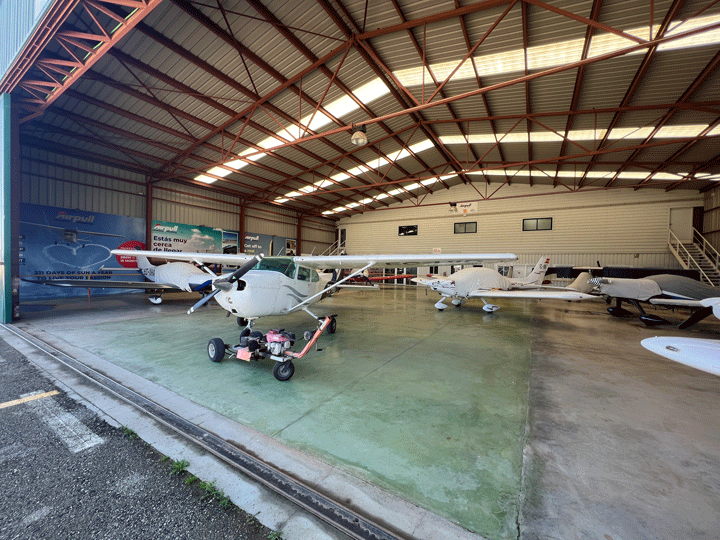
|
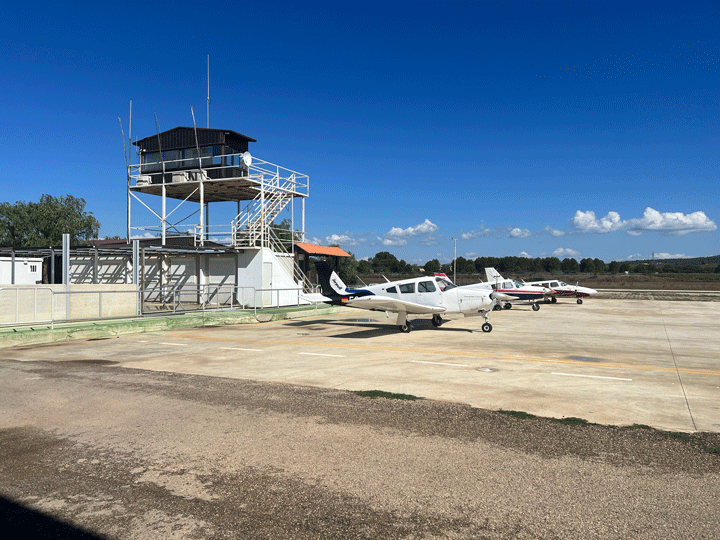
|
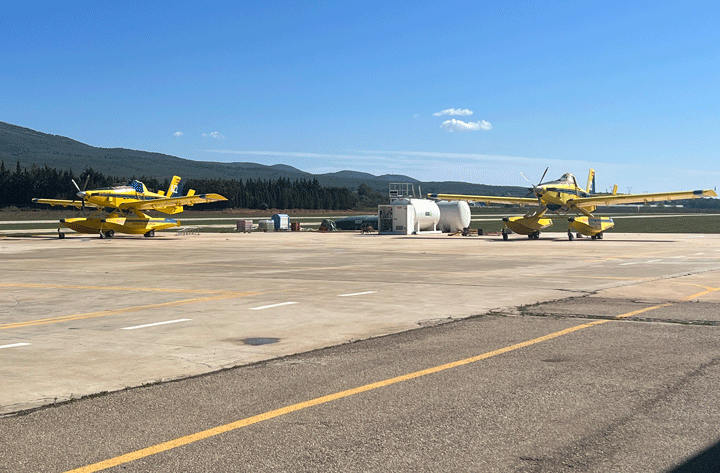
|
Eventually a fuel man appears to whom we would normally have to pay the €10 landing fee but my instructor works here sometimes so has the requisite "I am locally Based" card so it's free today.
When we're ready to depart we taxy up and power check. At this point I think I didn't push the handbrake release firmly enough in (normally they are spring loaded) to release the brakes completely.
Our acceleration up the runway is a little slow but I put this down to the height.
We climb out and I think no more about it, turn to our homeward track and we fly back over the mountains.
We will approach the airfield via Point November, another "swimming pool" to the North of the airfield.
Announcing our intentions, the tower tells us they have chnaged the runway and we're now on R12, with that bloody approach over the lamp posts.
Join crosswind, slow the aircraft down and we're loking for 65Kts on Final, 900ft over the pylons and it's all going OK until I'm over the numbers and the heat off the runway kicks us back in to the air. We float for a while as the now uselss runway speeds beneath us. I can land it OK but it's long.
The brakes are feeling weird, I can't get any differential braking and I can't turn the aircraft, it also needs a lot of power to backtrack. Finally I realise the brakes are partly on and no amount of pushing and pulling will get them to release properly. There is something wrong here and it's not just me being stupid.
Requena solo 3 Oct 23
For my first solo Spanish trip I'll go up to Requena, repeating the flight I did with my instructor a couple of weeks ago, but return via the longer coastal route to mix things up a bit.
As I am without instructor I'm not trusted to walk across the runway (you what?) so I have to pick up the aircraft paperwork from the office then drive round the end of the runway on a track that is in a little cutting so the aircraft don't take the roof off the van (and you don't take the wheels off the aircraft).
Contained with the aircraft keys is a gate key, but which of the 3 gates behind the hangar, all overgrown with scrub, this fits is anyone's guess?
Parking behind the hangar, there is a great smell of... well let's say it's something not legal. Pausing for a moment to inhale deeply, I'll open the correct gate and head round the front of the hangar where the C172 is sitting at the back, behind 2 C150s. One is off to Requena for a new engine, the other has just returned with a new engine.
Cue much use of the AvGas powered tug, before finally everything is outside.
As I'm going to be back during their siesta I've got to put the aircraft away, apparently they will leave the hangar door unlocked for me.
One of the instructors jumps in to the C150 and I'm left to preflight the C172 in peace. Apart from a blown landing light all is good but the fuel dip is so worn it's unreadable and there's not enough fuel in it for my liking so we'll start and taxy over to the fuel farm.
Prior to taxiing I do request the fueller from the tower but on arrival all is deserted. Now, the question is "do I stand around like a lemon or pump it myself?"
Reset the indicator, connect the Earth lead, fill the far tank, fill the near tank, and just as I'm putting the Earth lead and ladder away the fuelling hombre arrives and is horrified to see I've touched his precious equipment.
Us irresponsible pilots are apparently not allowed to refuel the aircraft.
Well, matey, if you're going to take that long to turn up you must expect us to take the initiative...
Open my SkyDemon flight plan by phone via the undocumented phone number and start up.
We're on runway 12 as normal so backtrack, roll and climb out via downwind to the northeast.
4000ft is much easier to achieve with 1 person on board and we aim just to the right of the big swimming pool, then over two hills.
There are 2 Valencia frequencies 120.400 S and 120.100 N, so we start with the South and swap half way through to the North. Again, this is undocumented.
All radio traffic is English airliners (Ryanair and EasyJet) or German airliners (Eurowings).
We do a re-run of our previous approach to Requena, as I'm still high on Downwind having come across the mountains so it's glide approach time and a little too much energy in the flare meaning a long-ish landing, taxy in and park up.
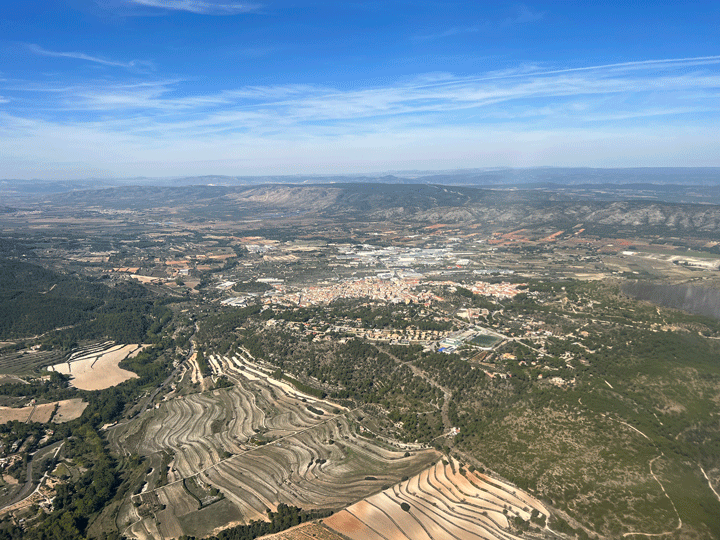
|
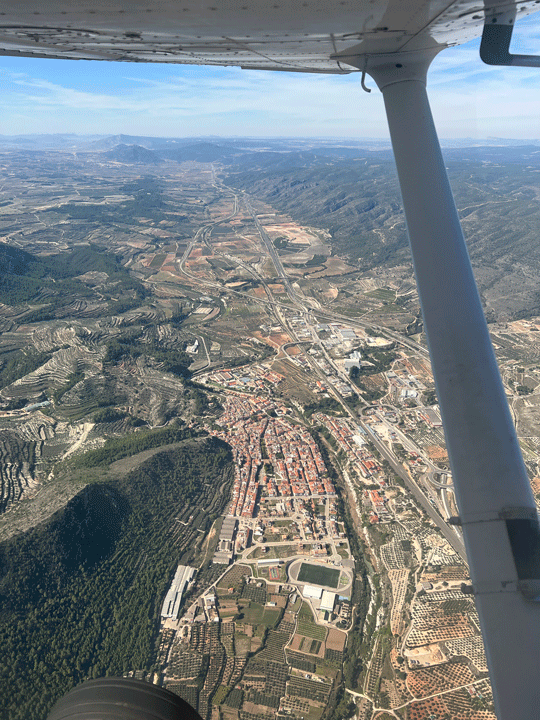
|
|---|---|

|

|
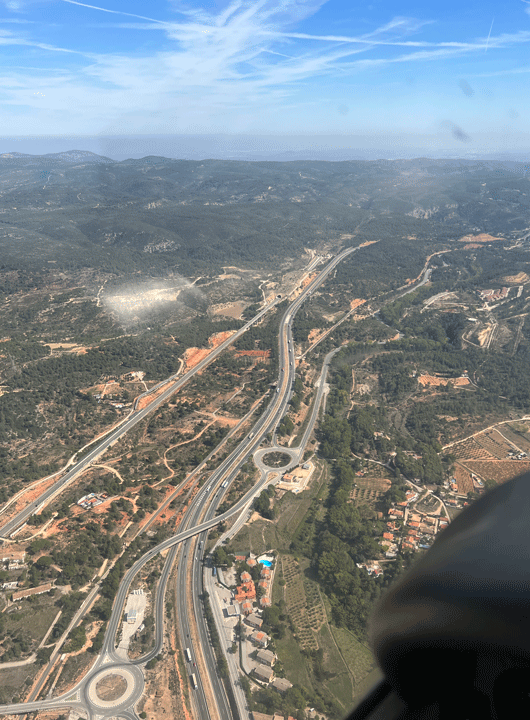
|
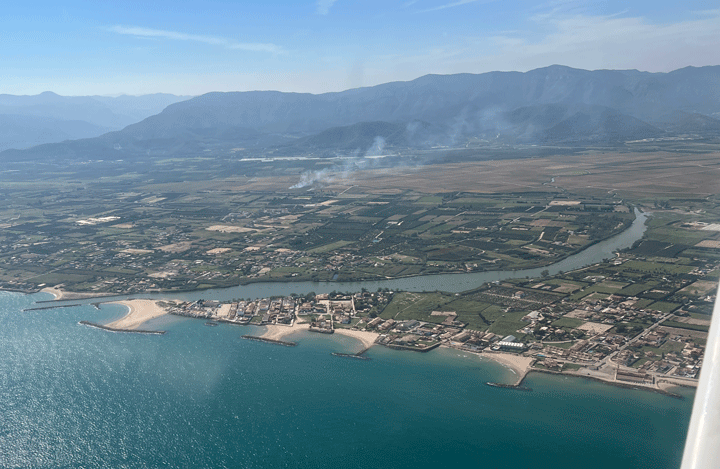
|

|
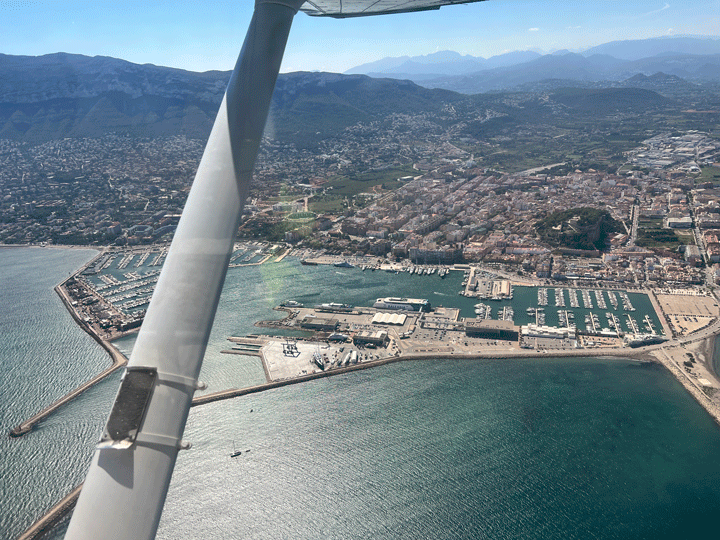
|
On Tuesdays and Wednesdays there is no one in the tower so you pay your €'s to the fueller, who has just started to fuel a SIAI-Marchetti and a Cessna 180 from Belgium on their way to Dakar. They are very friendly and all are wearing pukka pilot shirts with 4 bars, apparently vital in Africa as they don' think you're a pilot unless you are wearing one!
It takes 40 minutes for the fueller to do what I could have done in 10 minutes but finally he is free and before he can start to fuel the next Cessna I grab him and demand to pay my €10, for which he has to hand write a receipt as his WiFi has stopped working. It's OK, this is Spain and I am in no hurry.
I want to return via the coast but whilst SkyDemon will quite happily build a flight plan with many Lat and Long turning points I am reluctant to file a flight plan such as this after my Belfast "ah, you're the one with the flight plan..." fiasco, so I put in DCT and in the notes field write in VIA COAST.
The undocumented Flight Plan phone number is continually engaged so I'll open it on the radio (I hope, not quite sure that's allowed...)
There is a PA28 sitting at the Hold and politeness says I should wait for him but he's faffing about so I'll park next to him for power checks, then just go. He's still sitting there as I climb out.
I swap to Valencia North, ask them to open my Flight Plan (which is fine) and just state "routing via the coast" which is also just fine. They are actually very relaxed.
The hills West of Valencia, starting at Buniol, are sudden and very steep, the Motorhome struggles getting up them and initially I am shielded from him by them but then he says he can see me, so I can descend to 3500ft.
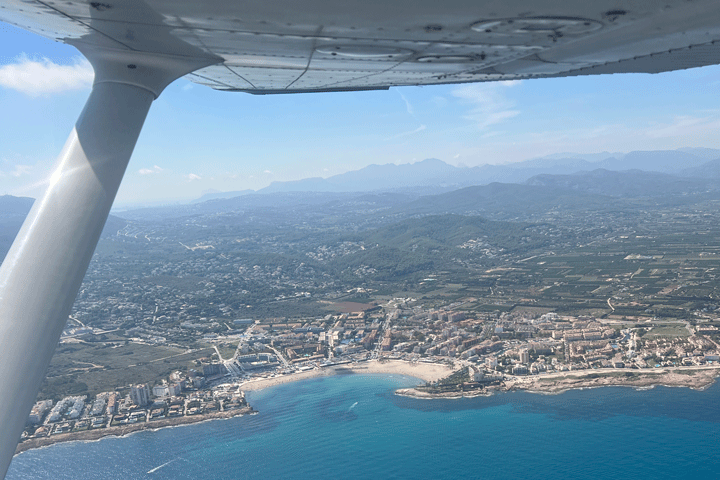
|

|
|---|---|
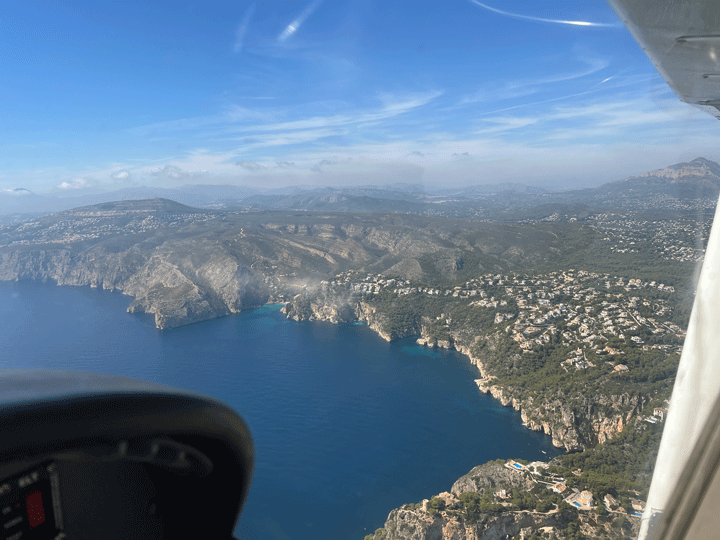
|
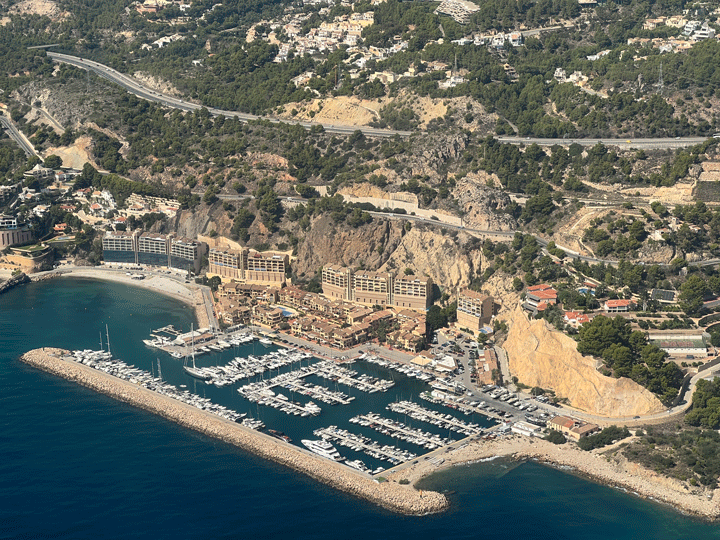
|
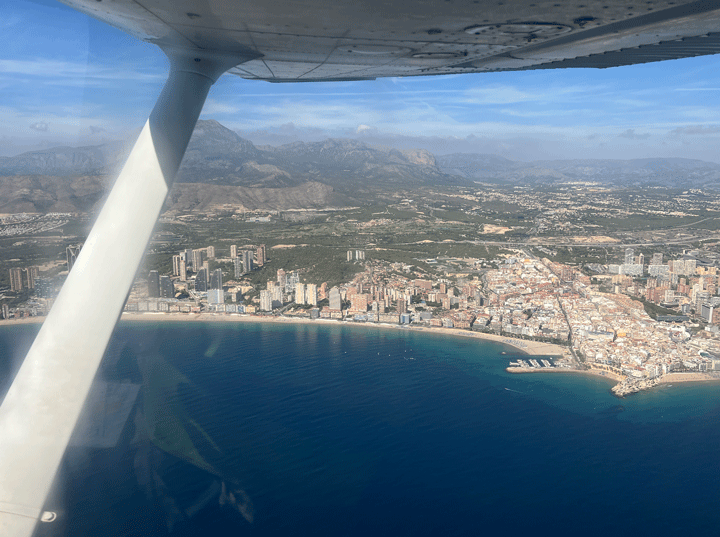
|
|
From here the coastal plain looks misty but it's just a hint of moisture in the air and probably some pollution, the viz is actually very good.
At the coast we can descend to 1,500ft and turn right at Cullera.
The coast between Valencia and Denia is sometimes just orange fields all the way to the beach but is often very built up.
Behind the tourist coastal strip all the way to the hills is uninterrupted orange fields.
Further South is Denia harbour for ferries to Ibiza, Mallorca and Formentera then the hills move closer to the coast, starting with the Montgo between Denia and Javea.
Then the Eastern tip of this part of Spain, between Javea and Moraira, then on to Calpe, Mascarat and Altea before the horrendous blight that is Benidorm, then Villajoyosa and we can see Alicante now.
N Valencia have faded behind the mountains so swap to S Valencia, check in with them and swap back to Muchamiel, join via point Echo right downwind for R12, do the approach as low as I dare, expect thermals off the hot runway so float a bit. Ho hum, so much for hiting the numbers. A gentle arrival, if long, so backtrack and park outside the hangar which is not, as had been promised, unlocked.
Parking the aircraft neatly I leave an apologetic note, climb back through the gate to the dope bushes and the waiting Motorhome for a long glass of water.
Benidorm 29 Jan 24
I havent flown with the Aeroclub for more than 90 days so they want me to do a couple of touch and go's with my friendly unshaven instructor. We're on R30 today so life is simple, and the C172 is a known quantity.
So let's see if we can chase down the elusive perfect arrival.
My time with the PA28-140 at the relatively short Henstridge has tamed my approach speed desires to somehwre approximating what I probably should have been using for the last 19 years. We'll nail the approach speed to 65Kts with 20deg flap, and 60Kts over the numbers, or less.
The first one goes swimmingly, there are no thermals and no bits of wind so I can really wring out the last couple of inches above the tarmac, ignore the stall warner warbling away and just... stop... it... touching. Ooh, it touched.
Round again, he thinks I'm too low over the power cables just beyond the peage motorway (someone hit these cables recently, apparently) so we'll aim for 700ft over them. But this means I have to really roll the power off once we are over the cables to get anywhere near the numbers. Another pretty good touchdown, and round we go for the last of 3.
This time, I get the 700ft, roll it right off and come in really low over the fence. A gasp from the right seat but it's finely judged and we're smootly down just after the numbers, gently rolling in. "Too low!" he says. Maybe....
With Spanish currency restored but not enough time to go to Castellon and get the plane back before it's needed again I'll go up the coast to Benidorm for some sightseeing. The weather in our valley is pants but down here on the coast it's CAVOK or better and I just cannot think of anything nicer to do than potter up here.
Back to the airfield via point E1 (a shopping mall), straight in, 700ft over the power lines and my 4th decent arrival of the day, so I think my method is working. My original Skills test instructor did say "now go away and do 1,000 landings". My logbook tells me I have done 700 or so, maybe i am bgining to understand the principles.....
Javea 5 Feb 24
Sue wants a flight so after some to'ing and fro'ing with the Aero Club about the nose oleo leg on the C172 (looks fine to me but we'll trreat it gently) we can take it for a run up the coast this morning.
But by the time they have been late to open the front gate, late to release the aircraft and we have driven round and pre-flighted there is not much left of my hour and a half. We may be late coming back...
Fire up and depart on runway 12, this will be fun getting back in down that bloody slope.
 We are both in short sleeves, the coast is bright and sunny, the air over the water smooth and unruffled.
We are both in short sleeves, the coast is bright and sunny, the air over the water smooth and unruffled.
Valencia are not interested in us and we are outside controlled airspace for the entire flight so we dont need to talk to anyone.
Sue doesnt want to fly so we chat as the landmarks drift by: Villajoyosa, Benidorm then Calpe, Moraira and Javea before we turn inland and buzz her house near the Montgo and pop round to Denia to see the docks before turning inland over Jalon, climbing over the Col de Rates and back towards Benidorm.
We can probably make it back around 11:30am if we can somehow get them to change the runway so we can do a straight in approach.
There is no wind today and a German-registered aircraft approaching the field requests to use runway 30 so we simply slot in behind him and call long final for 30. the Tower grumpily agress but tells me I need to do a circuit. There is no other traffic and no wind so we'll just go straight in.
But even with no throttle and 2 stages of flap my indecision as to whether to do a circuit or not has left us too high on the approach. What would a good pilot do?
A good chunk of rudder and crossing the controls gives us a much better descent rate and by the time we're over the pesky power lines we're back where I need us so straighten up, call short Final and we get pretty close to a perfect arrival and little braking required for a vacation South to the hangar. We're only 5 minutes late which, given the chaotic scenes earlier, I think is pretty good
Castellon de la Plana 3 Apr 24
 Today we'll fly my friend Howard, a retired RAF C-130 and DHL 757 pilot with millions of miles flown up to a small strip 50 miles North of Valencia called Castellon de la Plana. We'll go direct and come back via the coast.
Today we'll fly my friend Howard, a retired RAF C-130 and DHL 757 pilot with millions of miles flown up to a small strip 50 miles North of Valencia called Castellon de la Plana. We'll go direct and come back via the coast.
After a scheduling cock-up the previous day causing us to cancel today dawns (as is normal) bright and sunny over the Costa Blanca, so we meet up and pre-flight the aircraft. This takes a while as he (obviously) has many questions, but he is impressed by the capabilties of Skydemon on the phone and iPad, especially its ease of raising flight plans via 4G, chuckling as he recalls the pain that raising a flight plan used to be.
We roll on runway 30, follow the circuit round then depart via point November to climb over the mountains, where it is surprisingly rough and hard to hold a height even this early in the morning but as the mountains recede and we descend over the Valencian plain it becomes a lot smoother.
We will fly whatever VFR route Valencia chooses for us but SkyDemon shows a VFR route over the city so we request and are granted that. We fly at 1000ft AGL (which somehwat limits our land-clear options in the event of an an engine failure) across the city, changing to Tower who inform us of an approaching 757 on the ILS for runway 30, we are swiftly visual with him but by the time we think about avoiding action he's past below us. Wake turbulence spreads downwards so we're safe from that here and proceeed North.
Tower is a bit grumpy and suggests next time we take the other VFR route over the sea, so we'll do that on the way back but we haven't actually done anything wrong.
The coast is dull North of Valencia: very flat and with few distinguishing features but with white beaches stretching as far as the eye can see. Castellon de la Plana is a small paradropping strip right next to the beach. The runway is in pretty good condition and 675m, so similar to Henstridge. I can do these now, so blind calls, left hand circuit over the sea, turn final for runway 18 over the fields and slow right down, over the canal, a short burst of power to just lift us over the hedge and we're down and stopped.
Parking up next to the paradropping aircraft we learn that Spanish for "I want to pay the landing fee" is "Quiero pagar la tasa de aterrizaja".
All of €7.
Coffee, I think. 100 yards away is a restaurant right on the beach. I'll come here again....
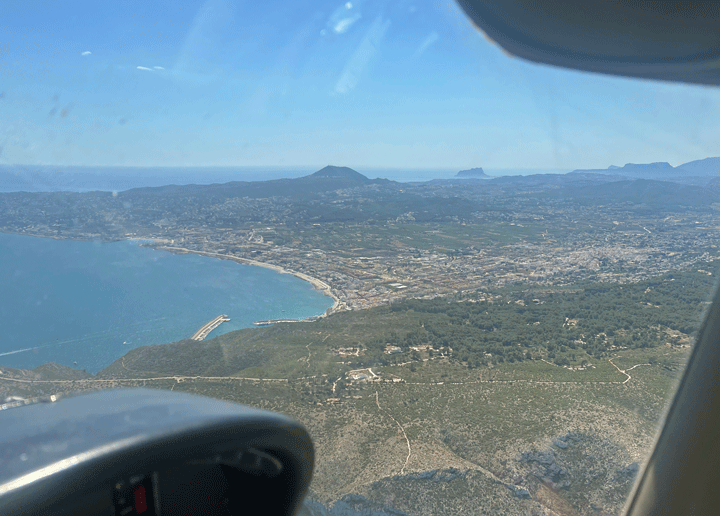 We can raise the return flight plan from the restaurant, but can we get the engine started? There is a knack to starting a hot, injected engine and as we all know every aircraft is different. We've flooded it, so crank it with mixture lean until it fires, then roll on 36, a right turn and back over the sea South. Howard can fly us back.
We can raise the return flight plan from the restaurant, but can we get the engine started? There is a knack to starting a hot, injected engine and as we all know every aircraft is different. We've flooded it, so crank it with mixture lean until it fires, then roll on 36, a right turn and back over the sea South. Howard can fly us back.
We select the overwater VFR route back past Valencia and then down the coast to Denia, Javea, Moraira, Calpe, Villajoyosa and all the way back to Muchamiel via point Echo, lining-up for a straight-in approach for runway 30.
Howard's smile has been growing as he flies it increasingly accurately and smoothly, he is contemplating getting an EASA licence. He has ATPL, CPL, 757 and 767 Type Ratings; of course they're all expired. But his "thrown-in" PPL doesn't expire.
As we call Final we can see a helicopter on the runway, which is fine: he has priority. He may well move before we land but he doesn't so I call going round at 500ft and slip in to the circuit.
By the time we have finished our circuit the runway is clear but I turn Base too soon so I'm still a bit fast as we come over the motorway; the aircraft floats for longer than I would prefer, but the landing is good, just long. Of course looking at the windsock it turns out we had a tailwind, hence the long landing. Never mind.
Message from Tower: we shouldn't have gone round over the top of the helicopter, we should have kept him in sight by doing an early turn circuit side or dead side. He could have taken off vertically and would have been climbing up in to me.
Fair enough, although he could have stated his intentions in English. But at least I made my Intentions and Actions clear, did not descend below 500ft and no one got hurt.
Local Muchamiel LEMU 23 Aug 24
Having been distracted by UK flying and domestic commitments I am now out of currency with the Aeroclub so Rafael and I are going to do some circuits on the infamous Runway 12. Learning to use this approach has been good for my skills so we're now going to try it at the hottest and bumpiest time of year.
The C172 looks much as I left it in April, but they now have a better checklist in English so we'll use that. It includes the line "test stall warner by sucking it".... I'm a little sceptical but if you suck on it, it does indeed wail. Well, every day's a school day.
Starting up, we visit the deserted runway - it's summer holiday time and no one else is flying except, confusingly, the Leading Edge Aviation ATPL trainees at Alhama de Murcia just down the coast who, in a masterful example of European 8.33KHz spacing, share exactly the same frequency as Muchamiel. Worth knowing...
The thermals on take off are enough to have to use occasional stop-to-stop control excursions, no gentle "steer by rudder" here. We can do the 1200ft circuit OK, the big push forward on flap extension and the 60Kts approach speed and now I'm used to following the ground down to the threshold we do end up in a sensible place on the runway each time.
After a couple we try doing a smaller circuits, turning inside the infamous "must be above 900ft" pylon line and this allows a much lower turn on to Final, so there's less energy to dissipate on Final and we can get to the threshold more under control. But the runway is hot and this aircraft doesn't stall until 40Kts with full flaps so flying it at 60Kts means you're going to float. 50Kts short final might be better for a really short roll, but maybe without an Instructor on board.
Anyway, after 5 we're both hot and sweaty so we call it a day, but not after one final attempt to stop before the first exit has me locking the brakes up before the flaps are fully up, something I am not proud of by any means.
Local Muchamiel LEMU 6 Sep 24
 Nessa has been quite understandably reluctant to fly with me since the bird strike a few years ago, but did manage Henstridge to Beccles and back a couple of months ago, so I’d like to show her the aerial delights of Benidorm and the mountains of Eastern Spain plus our house.
Nessa has been quite understandably reluctant to fly with me since the bird strike a few years ago, but did manage Henstridge to Beccles and back a couple of months ago, so I’d like to show her the aerial delights of Benidorm and the mountains of Eastern Spain plus our house.
The issue with renting aircraft is that you only get a 1½hr slot in which time you must pre-flight the aircraft, fly it, return it and do the paperwork before the next person takes it. Plus of course the random nonsensical rules the flight school apply. Having a share is a hugely more relaxed environment…..
Today this is exacerbated by having to unlock the hangar, open the doors and extract not one but two aircraft in order to fly the second one.
Only after realising I can’t start the Avgas-powered tug, removing the C152 from the front of the hangar and parking it then pulling the C172 out can we finally start the pre-flight. I am then told the Avgas tug is “only for instructors”.
Well, no one told me that before….
Even deliberately not checking the lights and stall Warner (for today these count as non-critical) can I do the A check in any kind of sensible time and by the time we’re ready to taxy I’m in a muck sweat.
This is exactly how accidents happen.
By the time we start up and warm up it’s 1030, so we only have 50 minutes tops to complete our mission.
Roll on R12 and depart to the North East - we are staying below CAS so no flight plan required and we can just leave the radio on Muchamiel for simplicity.
Up the coast to Villajoyosa then Benidorm, cut the corner up to Calpe then turn inland for Benissa, climb to maintain terrain clearance then in to the Jalon valley and up to Alcalali and Parcent to photograph our house and our neighbours’ houses.
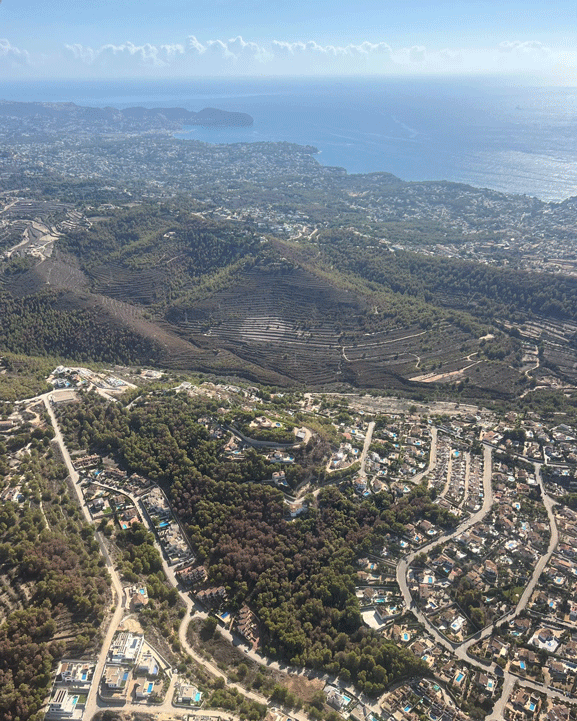
Here the Jalon valley is big enough to turn in so being well below the mountain tops is not an issue, but we’d like to climb over the Col de Rates to get back to the coast so we’ll gain 1000ft or so in a loose orbit then slip past the café on the col and it’s all downhill from here.
We’ll keep the throttle open and we get 120Kts all the way to Finestrat. Over the water and down to Villajoyosa then call rejoining for R12, the runway with the downhill approach.
We’ll do the shortened circuit, turn inside the power lines and can be at 500ft turning Final: much more controlled and less energy to dissipate.
I manage to get the approach correct but as always seems the case the hot runway makes the aircraft balloon just as we pass the numbers.
With power off, all we can do is ride the flare down for a smooth arrival, but we’re long and having been mortified by locking up the wheels last time (lose the flaps first to get the weight on the wheels) I over-compensate and don’t brake enough; we end up using nearly 1000m of the runway to stop.
Nice and gentle for the passenger, but not the right way to do it.
We are back on time but what a rush: not really enjoyable and relaxing.
Montauban - Cahors 29 Sep 24
Today we will fly to Montauban in France for fuel (they have a Visa AvGas dispenser whereas Cahors is Total-only), on to Cahors to pick up Wendy then return to Muchamiel.
This is a long trip over The Pyrenees and requires careful planning. A mountain range like this requires respect in terms of weather.
The fuel also requires careful thought but previous use of this C172 has shown that it really does do 108Kts at 8 USG/hr so I can, with confidence, plan a 4hr flight.
SkyDemon’s estimates are often wrong because incorrect aircraft performance data has been entered, and my C172 definition is no exception. For some reason it contains a lot of C182 settings so is in need of some adjustment, especially in the climb department. One adjusted it says I can get to Montauban today in 3hrs 53mins. Assumed endurance is 6hrs something at 8/hr or 5.3hrs at 10 (which is what I will use for a Safety Factor). We shall see.
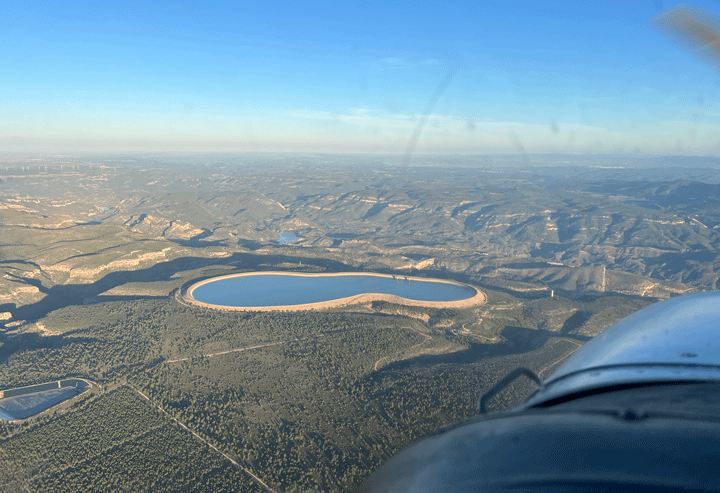 Muchamiel are a bit scared of me going and coming back in a day, calling it “tight” and “too far”. They are assuming I am going up via the coast, but I’m going to fly over part of the Pyrenees instead, a much shorter route.
Muchamiel are a bit scared of me going and coming back in a day, calling it “tight” and “too far”. They are assuming I am going up via the coast, but I’m going to fly over part of the Pyrenees instead, a much shorter route.
My planned route takes me just to the East of Andorra where the peaks are 10,000ft or so, they are higher further West.
The service ceiling of the C172 is 16,000ft and the VFR airspace goes up to FL125 so I don’t see why I can’t just fly over. Obviously it needs to be VFR and no strong winds, so today is perfect. A brief stint at 12,000ft isn't going to hurt either of us, although I don't intend to hang around at that height for long.
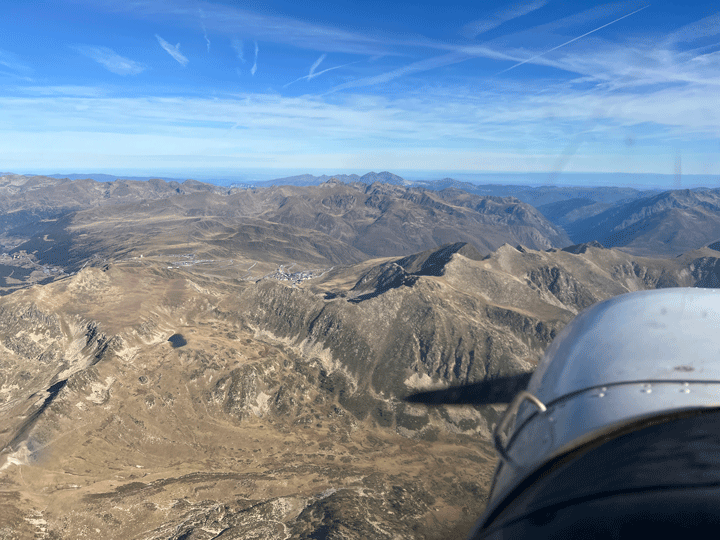 The Aeroclub opens at 1000 but the airfield is open sunrise-sunset so I arrive in the pre-dawn darkness to discover I don’t have the main gate key and of course it’s locked. Fortunately it’s a pair of gates so I can lean through, pull the ground pin and push them both open. I’ll probably be unpopular, but that’s just tough.
The Aeroclub opens at 1000 but the airfield is open sunrise-sunset so I arrive in the pre-dawn darkness to discover I don’t have the main gate key and of course it’s locked. Fortunately it’s a pair of gates so I can lean through, pull the ground pin and push them both open. I’ll probably be unpopular, but that’s just tough.
Open the side gate past the dope bushes, open the hangar and fish for the hangar lights. There are none.
Open the hangar doors by the iPhone light and there is just enough dawn light to attach the tow bar, pull the C172 out and turn it round. Shut and lock the hangar, file the flight plan from SkyDemon and preflight the aircraft.
Call Valencia - no flight plan. “Ah” she says, “try Alicante”. Alicante has the plan (thankyou SkyDemon!), open it and fire up the aircraft.
I can’t get the radio to work.
All the lights are on but I can’t hear anything in my headphones. Could be Muchamiel, so I’ll enter and depart non-radio and try Alicante. Half way down my non-radio backtrack my brain wakes up and realises I haven’t actually switched COM1 on, I’m using COM2…. Switch on COM1 and everything comes to life. Its too early!
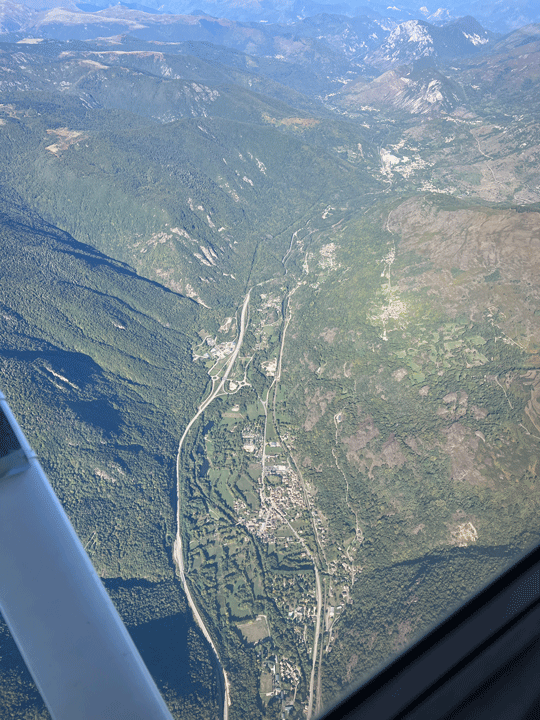 I’m actually not too bothered about flying over the Pyrenees but I am panicking about the fact that the EGT gauge is INOP so I can’t lean with any accuracy, necessary for high altitude work, and also me needing SkyDemon to run on both the iPad and iPhone, both use a fair amount of battery power and the aircraft has no 12V supply so I need power banks. I’ve charged all my available units and I hope I have enough power between them to power both units for 8 hours.
I’m actually not too bothered about flying over the Pyrenees but I am panicking about the fact that the EGT gauge is INOP so I can’t lean with any accuracy, necessary for high altitude work, and also me needing SkyDemon to run on both the iPad and iPhone, both use a fair amount of battery power and the aircraft has no 12V supply so I need power banks. I’ve charged all my available units and I hope I have enough power between them to power both units for 8 hours.
The secret to iPhone and iPad use is to set the screen brightness to manual and turn the brightness down quite a long way, you can still read it but it dramatically reduces the power used. Let's hope the reduction is enough.
Departing to the North East I have to climb to 5,000ft to get over the coastal ranges, the plan is to stay as high as possible for the whole trip rather than keep yo-yo’ing. I’ll pass behind Valencia in their VFR sectors below their airliner bits then just keep going North East all the way to Andorra.
The iPad now decides it can’t see the GPS satellites, no amount of jiggling seems to help, so in good IT support fashion I’ll turn it off, leave it a couple of minutes then turn it back on. It then works perfectly for the rest of the day. Huh?
This sort of trip is very GPS-dependant, there aren’t enough radio aids to allow navigation and VFR…. all the towns look the same. Turn-Time-Distance? Yeah, right.
Valencia assign me a squawk then basically ignore me, when I request a climb up in to their zone for terrain clearance they just tell me to do what I want, so I do, they then pass me to Barcelona who say the same thing, allowing me to transit all the TMA zones around Leída. So long as no one tells me not to do something I'm just going to carry on. A couple of times Barcelona chats to me in Spanish so I have to ask them to "hablar en Ingles, por favor" which they are happy to do.
Unlike the UK where there's always some bloke in a PA28 doing something crazy, here in Spain there is very little GA so it's just me, the EasyJets and Ryanairs but suddenly up comes "American 429 Heavy" inbound to Barcelona. I still get a kick out of using the same radio frequencies as the heavy iron.
North of Leida the terrain starts to lump up so I simply climb and climb until what’s in front of me is below me. At 6,000ft we go to Flight Levels on 1013 and now I can see Andorra airport to the left and one last ridge at 11,000ft. The climb rate becomes glacial but we do still climb and I ensure I always have a downhill escape route, if the engine stops at this point I can make Andorra airport.
I’m missing the working EGT gauge so lean as far as I dare. We need some richness to cool the engine, but it’s only 25° today and the engine temperature has barely risen from normal.
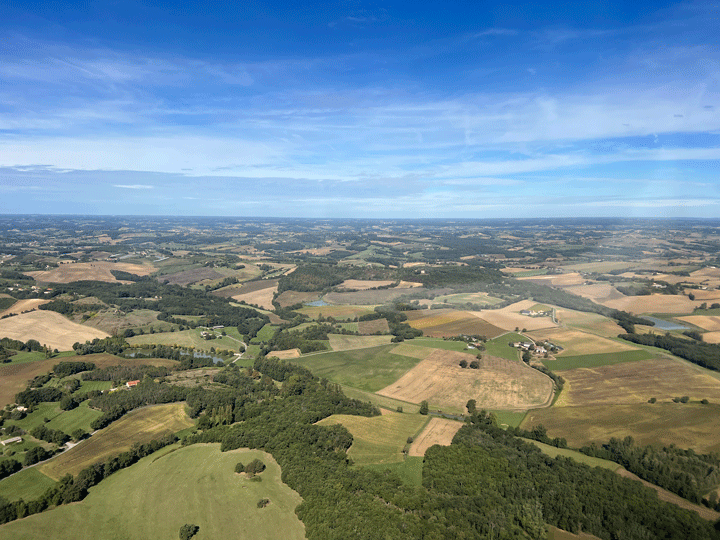 Suddenly the engine coughs…. Eek!
Suddenly the engine coughs…. Eek!
I don’t know why and it doesn’t repeat but I think it wants to remind me that this is a single-engined aircraft over inhospitable terrain…..
Barcelona transfer me to Bordeaux at the border and it must be said that despite the terrain I never lose two way radio communication the whole trip.
SkyDemon flight planning simulation mode has yellow/red bits that show you which bits of tyerrain are above you or at a similar height but this doesn’t seem to work in flight. I’m doing something wrong, more research required.
And then I’m over the ridge and it’s all downhill in to France.
There is controlled airspace here soon and low down so I do need to pull the throttle right back and dive to get under it. I can orbit if necessary but I can’t just go fast - without a wobbly prop the engine will over speed.
It’s noticeably much greener North of The Pyrenees, they are a huge block to rain coming in from The Atlantic.
Once below 4,000ft then 3,000ft I’m down to 1800ft and everything seems very close and fast, I’ve been at 6,000ft for so long it takes a while to get used to being so low.
Montauban is impossible to find without GPS: I don’t see it at all until I am within 3 miles, then it suddenly appears from behind a little ridge, in the midde of the town.
Pidgin French circuit calls determine they’re on R13 (La Treize) so I’ll join "Vent Arriere pour la Treize" re then "Basse pour La Treize" low over the town.
I'm going to experiment with using just 2 stages of flap, this aircraft floats too much with three. So get the speed back (vital with a C172), and this results in a nice smooth arrival without too much float (but with a lot of stall-type noises), and we can taxy in for the pumps. That was a good plan.
I close my flight plan on the universal French flight plan closure number and nip in to the office pour payer le tax d’atterisage. The charming owner smiles, says it is “libre” and helps with fuelling the aircraft. Don’t believe anyone who says you need advanced French to fly in France, my schoolboy French does the trick every time. But I do try, and I smile a lot....
Start up again, "rouler" (taxy) over to the Hold behind a Tecnam, power check and roll once more for the 12 minute trip to Cahors, whose pumps only accept Total. France, ay?
Cahors is parachuting and again French only but I chat to the jump pilot who is happy for me to land on 13 just not via the overhead.
I can do that and once again with the two stages of flap we're down smoothly and slow enough to catch the taxyway to the huge and entirely deserted apron. They know I am coming as I have e-mailed them so the access gate is open, and Wendy is there waiting.
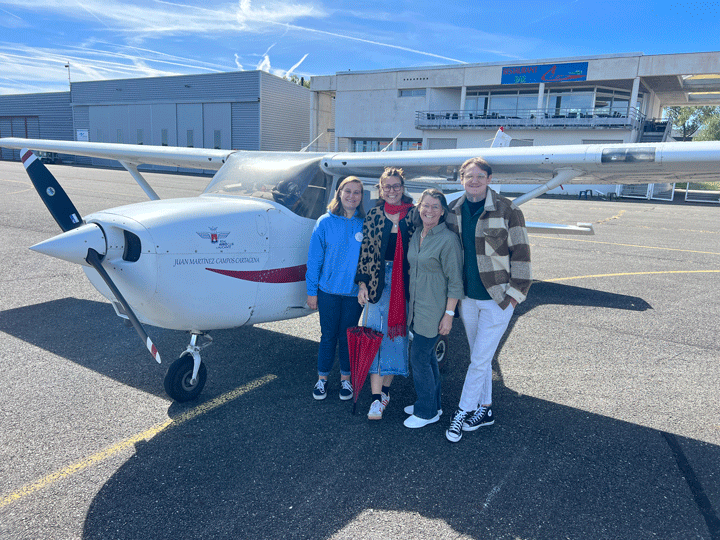 I’m the only aircraft on the tarmac, tower is closed so there is no landing fee (I love flying in France), the gate is open and Wendy has sandwiches…. and luggage. Not enough to put the CG out of bounds but worth contemplating for the climb over the mountains.
I’m the only aircraft on the tarmac, tower is closed so there is no landing fee (I love flying in France), the gate is open and Wendy has sandwiches…. and luggage. Not enough to put the CG out of bounds but worth contemplating for the climb over the mountains.
File another flight plan from SkyDemon, but the French flight plan phone number says I must open it in the air. OK…
Load up Wendy, call entering the runway and manage to get treize and Trente mixed up, but no one is listening anyway…
Take off, climb to 1800ft and can’t get Toulouse or Bordeaux on the radio so they’ll need to wait while we orbit Wendy’s village for photos then head for Toulouse.
Eventually Toulouse can hear us so we open our flight plan, then as the Pyrenees loom larger we start our step climb. I can stand being in the Danger Areas as I know they are cold today but do want to remain outside the various bits of Zone. Eventually we are clear of everything except “VFR to 12,500ft” so I can pour on the coal.
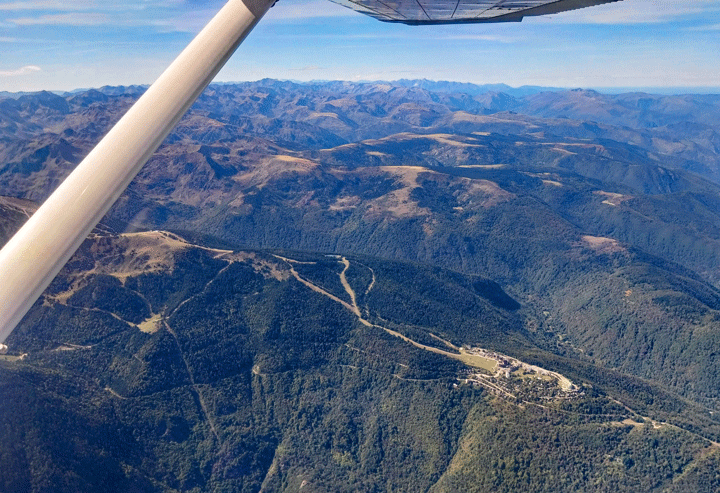 With Wendy on board and full fuel we’re heavier than on the journey up and past 6,000ft it all gets a little slow. I’m facing up the valley I came down earlier and I’ve always been told never to fly up valleys as they get narrower and if you can’t outclimb the terrain you may also not be able to turn round. So we’ll orbit for height. Always have a way out.
With Wendy on board and full fuel we’re heavier than on the journey up and past 6,000ft it all gets a little slow. I’m facing up the valley I came down earlier and I’ve always been told never to fly up valleys as they get narrower and if you can’t outclimb the terrain you may also not be able to turn round. So we’ll orbit for height. Always have a way out.
In practise it only takes one orbit before I am confident we can get over the top, we pass at 45° over the ridge at FL120 with Andorra to our right, again that’s my escape route, and then it’s all downhill from here, the stressful bit is over.
We are the only GA traffic on the Barcelona side so again we get to do what we want and Wendy flies us, conforming to the string bag and octopus inexperienced pilot method of over-controlling and porpoising.
North of Valencia I am beginning to panic about fuel.
The low fuel light has been on for some time. My fuel calculations show we have loads but the gauges are slowly going down.
We change plans and decide to cross via Valencia’s "out to sea" route at 1,000ft.
Wendy finds this very hard work, being close to the water and by the time we cross over Cullera’s lighthouse she’s ready to give me back control and I’m ready to cut the corner and instead of doing the scenic coastal route go over the top via Alcocera and direct to Muchamiel.
I’m half expecting the engine to cough as we climb over the hills to 4,000ft, just enough to clear the tops, engine leaned aggressively in the cruise but finally we’re over the last hill and I can see the runway.
Drop Alicante, switch to Muchamiel and ask for airfield information. None being forthcoming I elect to land on runway 30 and call "Joining via E1".
 In the afternoons this usually gives us a bit of a tailwind, but it’s a long runway and I prefer a tailwind to the downslope R12 approach, so we join right base for R30 with two stages of flap, over the motorway and down neatly on.
In the afternoons this usually gives us a bit of a tailwind, but it’s a long runway and I prefer a tailwind to the downslope R12 approach, so we join right base for R30 with two stages of flap, over the motorway and down neatly on.
We seem to be taking up lots of runway but that’s the tailwind, so gentle braking and we’re off at the hangar exit.
Evryone else has long gone home (it's 5:30pm) but taxying in, the Tower finally wakes up and asks why we landed on R30?
“Because I hate the R12 approach, there’s no other traffic and no one told me not to” is my pithy response.
I still have no idea whether he is curious or telling me off.
He also says Alicante have been calling him about my flight plan. Give me a chance to land, why don’t you?
We stop the engine, call Alicante to close the flight plan and push with the tow bar back in to the hangar. It’s surprisingly difficult to get it straight, we have to back and forth a bit. It's tight and I really don't want to ruin the day by dinging a wingtip.....
Then dip the tanks…. still 12USG left, so 1½hrs flying! We could have done the scenic coastal route after all. Another time.
Prior to the flight I carefully edited SkyDemon’s C172 profile to ensure accurate figures for cruise, climb and descent and whilst it added 20 minutes to my estimate, it actually turns out to be accurate within 2 minutes over 3.5hrs, not bad.
The aircraft performed to spec, did not need topping up with oil and all the electronics worked, I didn’t need half my power banks and neither iPhone nor iPad ever dropped below 85%.
Lots of learning, but basically The Pyrenees are, on a good day, not that scary.
Local 4 Feb 2025
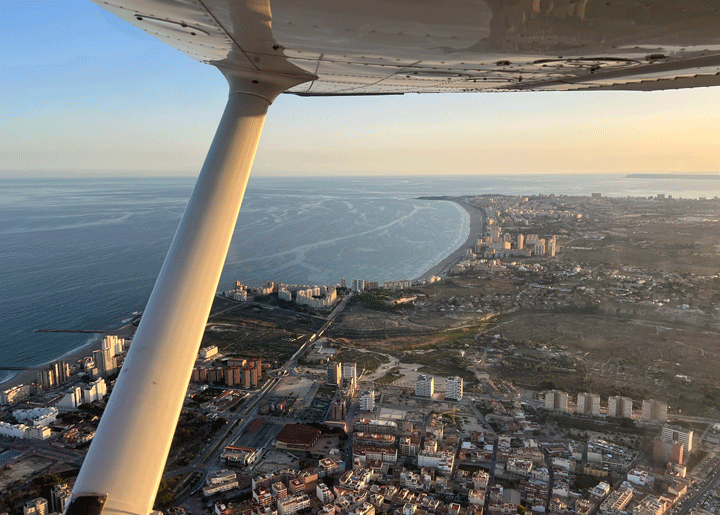 Once more I am reminded how annoying flying with a club is... I am out of currency with the Spanish, despite having actually flown only 4 days ago, so yet more circuits with Rafael. It's late afternoon and the weather is just perfect today: no wind, 15° and sunny. The sort of perfect aviation day English pilots dream about, that occur every other day here.
Once more I am reminded how annoying flying with a club is... I am out of currency with the Spanish, despite having actually flown only 4 days ago, so yet more circuits with Rafael. It's late afternoon and the weather is just perfect today: no wind, 15° and sunny. The sort of perfect aviation day English pilots dream about, that occur every other day here.
I don't really mind: I enjoy circuits, Rafalel is fun, I learn something every time and teach him a bit of obscure English (today it's "logbook" and "spats"), my pre-flight turns up a misplaced pipe in the engine bay we are able to bend back in to place and some query about the oil level as the dipstick simply isn't marked, but the C172 is ready to go and we fire up for some circuits.
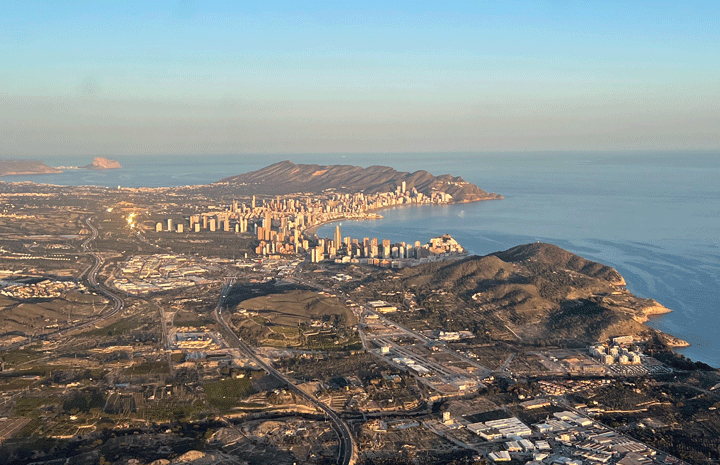 I'm better with this R12 approach now, I basically ignore the hill, ensure I am 900ft over the power line, use 2 stages of flap for less lift at the flare and don't try to get it down too soon, there's plenty of runway. My landings are not perfect but they are smooth and predictable, I just really need to do loads more on this runway to get the relaxed short landings I seem to be able to manage consistently at Henstridge.
I'm better with this R12 approach now, I basically ignore the hill, ensure I am 900ft over the power line, use 2 stages of flap for less lift at the flare and don't try to get it down too soon, there's plenty of runway. My landings are not perfect but they are smooth and predictable, I just really need to do loads more on this runway to get the relaxed short landings I seem to be able to manage consistently at Henstridge.
After 4 he is happy and pops out on the taxyway so I can have a solo run up the coast to inspect the reservoir at Guadalest following loads of rain. Well, that's my excuse anyway... Actually I just feel like going out.
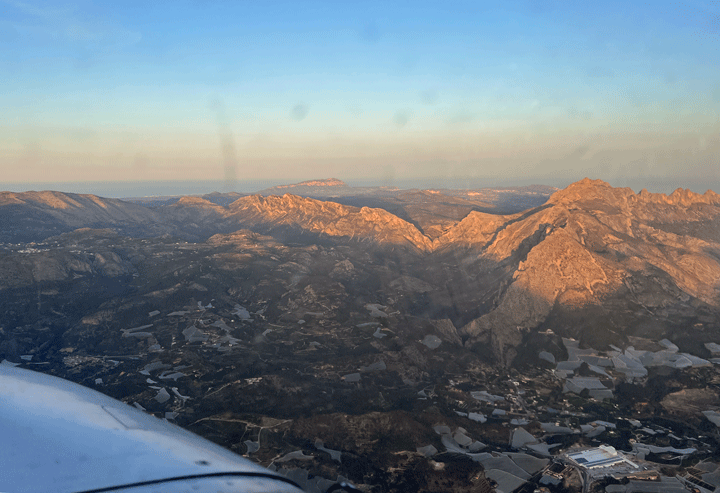 Being winter it's really smooth as we depart North east up the coast, past Villajoyosa and Benidorm then climb North West up towards Guadalest.
Being winter it's really smooth as we depart North east up the coast, past Villajoyosa and Benidorm then climb North West up towards Guadalest.
The reservoir looks surprisingly not very full but the smaller reservoirs closer to Alicante look absolutely full, so there may be reasons why they are not allowing Guadalest to fill completely.
Certainly the Spanish have stopped using the word "drought" so clearly they've had enough rain this winter to get them back in to a tolerable situation.
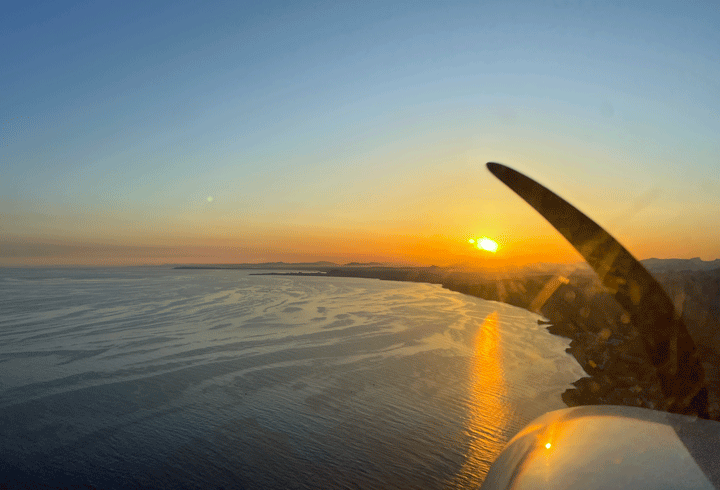 I am a bit short of time as the sun is rapidly going down but there's time (there's always time) for a few steep turns over Benidorm, a quick HASELL check then some clearing turns and a nice steep orbit, keeping the horizon nailed on same spot on the engine cowling all the way round and lose no height. Can we do it the other way round? Yes. Bloody show off...
I am a bit short of time as the sun is rapidly going down but there's time (there's always time) for a few steep turns over Benidorm, a quick HASELL check then some clearing turns and a nice steep orbit, keeping the horizon nailed on same spot on the engine cowling all the way round and lose no height. Can we do it the other way round? Yes. Bloody show off...
Descending gently in to the setting sun the Northern outskirts of Alicante are below, a Spanish pilot is joining downwind for R12 giving one of his normal, non-ICAO standard rambling Spanish calls so I can slot in behind him and call Downwind at which point he swaps to English. Bloody right: use the proper langauge!
900ft over the power cables, close the throttle and nail it on 60Kts and all goes swimmingly, no balloon at the flare and we're gently down and off on to the taxyway with no drama. One of the other instructors is there to push the plane in to the hangar with the AvGas-powered tug, by the time we have done all the paperwork it's full dark. But an excellent afternoon.